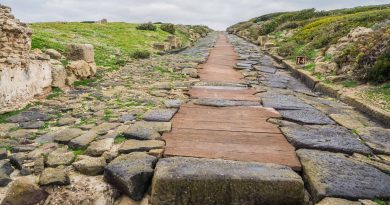Minerals found in Prehistoric and Roman Quarries
Extract from the Book ‘Ancient Prehistoric Canals (Dykes) – Wansdyke (Minerals found in Prehistoric and Roman Quarries)
Contents
- 1 Introduction
- 2 1. Pigments
- 3 2. Copper
- 4 3. Tin
- 5 4. Gold
- 6 5. Lead
- 7 6. Silver
- 8 7. Zinc
- 9 8. Iron
- 10 9. Coal
- 11 10. Oil Shale
- 12 11. Peat
- 13 12. Jet
- 14 13. Amber
- 15 14. Flint
- 16 15. Polished Stone Axes
- 17 16. Building Stone
- 18 17. Ornamental Stone
- 19 18. Limestone
- 20 19. Quernstone
- 21 20. Clay
- 22 21. Salt
- 23 Further Information
- 24 Other Blogs
Introduction
- Mineral Pigments
- Copper
- Tin
- Gold
- Lead
- Silver
- Zinc
- Iron
- Coal
- Oil Shale
- Peat
- Jet
- Amber
- Flint
- Polished Stone Axes
- Building Stone
- Ornamental Stone
- Limestone
- Quernstone
- Clay
- Salt
Conclusion
In the captivating pursuit of unearthing the secrets of our island’s prehistoric history, our extensive mapping and research endeavours have unveiled a fascinating dimension previously unexplored. Utilising cutting-edge LiDAR technology, we have revealed a complex network of Dykes, Linear Earthworks, and Hill Sites—archaeologically recognised as hill forts and causewayed enclosures. These enigmatic structures provide valuable insights into the ancient landscape, shedding light on the activities of our ancestors as they engaged in the extraction, transportation, preparation, and trade of raw mined materials.
The enigma that now grips our attention is profound: What drove ancient humans to erect such impressive engineering structures and enduring wonders? As we delve deeper into the archaeological record, we are fueled by the quest to comprehend the forces that shaped these remarkable landmarks.
The discovery of these engineering feats has sparked a sense of wonder and curiosity about the motivations that guided the lives of our prehistoric forebears. The sourcing and processing of these raw materials held immense significance in the socioeconomic dynamics of ancient societies. Establishing intricate hill forts and causewayed enclosures signifies a complex resource exploitation system and trade networks that span vast distances.
We endeavour to unravel these raw materials’ mysteries through rigorous archaeological analysis. We aim to identify their geological origins, discern the extraction methods employed, and understand the technological prowess required for their preparation. Furthermore, we seek to grasp the cultural significance of these materials, as evidenced by their use in the construction of monumental earthworks and awe-inspiring structures.
Our pursuit of understanding is not solely driven by scientific curiosity but also by the conviction that studying these materials is vital to unlocking the secrets of our ancestors’ lives and societies. Preserved within the fabric of the landscape, these materials serve as tangible remnants of ancient human endeavours, providing a unique window into the distant past.
As we continue our archaeological investigations, we approach the task with humility and a profound realisation that the ancient world was a realm of intricate interconnections and complex interactions between humans and the environment. Our meticulous research aims to foster a deeper appreciation for our prehistoric predecessors’ ingenuity and resourcefulness and shed light on their actions’ profound cultural and social implications.
In the face of these awe-inspiring monuments and enigmatic sites, we marvel at the resilience and creativity of ancient humans, who, millennia ago, left an indelible mark on the landscape—a mark that continues to captivate and inspire us to this day. With reverence for the past and an unwavering commitment to unravelling its mysteries, we acknowledge that each discovery serves as a stepping stone toward a more profound understanding of our shared human heritage.
Scowles
In the fascinating pursuit of unveiling the secrets hidden within the British landscape, the extraordinary LiDAR surveys have revealed a multitude of scattered pits, entwined with the enigmatic features of Dykes, Linear Earthworks, Hill Side sites, and Earthworks. Yet, the true essence and purpose of these enigmatic pits continue to challenge the curious minds of the archaeological community. Previous excavations and speculative interpretations have offered but a glimpse into their potential ritual and ceremonial significance, leaving us yearning for deeper understanding. Among these captivating pits, one intriguing type, nestled in the heart of the Forest of Dean in Gloucestershire, England, has captivated the attention of investigators.
Traditionally, the Scowles were perceived as remnants of ancient open-cast iron ore extraction, tracing their origins to the early historic eras. However, the intrepid Forest of Dean Archaeological Survey research dares to challenge this perception, proposing an alternative narrative. According to their audacious proposition, the genesis of these peculiar formations lies predominantly in the arms of nature, moulded over aeons, and later embraced by human endeavours.
The genesis of Scowles unfolds over millions of years, a grand tapestry woven around geological outcrops of Carboniferous limestone and sandstone. Deep underground, ancient cave systems took shape, where iron-rich waters from the central Forest area bestowed their treasures upon the crevices, delicately depositing iron ore within.
Through the ceaseless dance of erosion and uplift, these once-secretive caves emerged into the daylight, revealing themselves as deep hollows and exposed rock formations. In the intimate context of the Forest of Dean, this geological tale finds its harmony, but the riddle deepens as we confront the widespread occurrence of akin pits across the vast expanse of Britain.
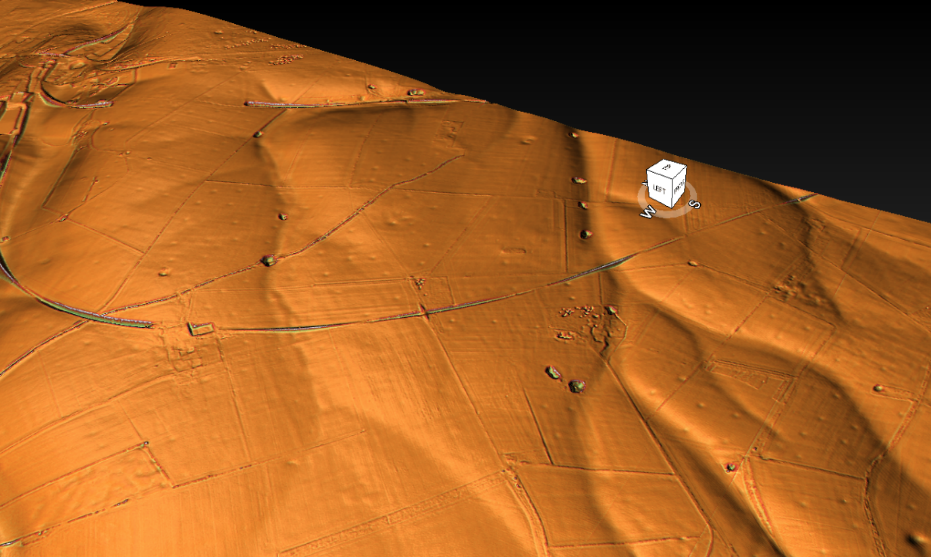
Wansdyke shows the same pits by prehistoric Paleochannels.
In the age of Iron and Roman empires, the discerning gaze of humanity beheld the hidden treasure concealed within the rugged countenance of Scowles. With sagacity and determination, they delved into mining activities, extracting the precious iron ore destined for the transformative flames of smelting and eventually gracing the world in trade and utility. Regrettably, the passage of time, with its inexorable hand, has obscured direct evidence, rendering the exact dating of this exploitation an elusive pursuit thwarted by the constraints of resources and funding.
The very term “Scowle” is adorned with linguistic charm, bearing traces of its origin in the ancient Brythonic tongue, where “crowll” whispers of a cave or hollow, or perhaps the Welsh “ysgil,” hinting at a recess. The echoes of a bygone era resonate through language, offering a fragment of the tale that once unfolded amidst these natural wonders. Yet, despite the strides made in discerning the natural genesis of Scowles and their intriguing human connections, the overarching enigma pervades. The broader distribution and the precise historical context of these pits, scattered across the tapestry of Britain, continue to defy definitive explanation, beckoning us to embark on an intrepid journey of investigation and inquiry.
We stand humbled by the enigmatic mysteries etched upon our land. Each revelation entices us to explore further, to reach beyond the frontiers of knowledge, for it is in the relentless pursuit of understanding that the light of enlightenment shines brightest. As we traverse the hidden passages of time and delve into the heart of the Earth, may our quest for knowledge illuminate the shadows of the past, painting a vivid portrait of the ancient world and its indomitable spirit. With awe and wonder, we gaze upon the Scowles, an enduring testament to the intertwining of nature’s artistry and humanity’s inquisitive spirit.
Non-ferrous Metals
Prehistoric Copper Mining in Britain: Since the late 1980s, archaeological research has focused on prehistoric copper mines in Britain, particularly in Wales. Twelve sites dating to the Early Bronze Age have been discovered and excavated, with significant publications.
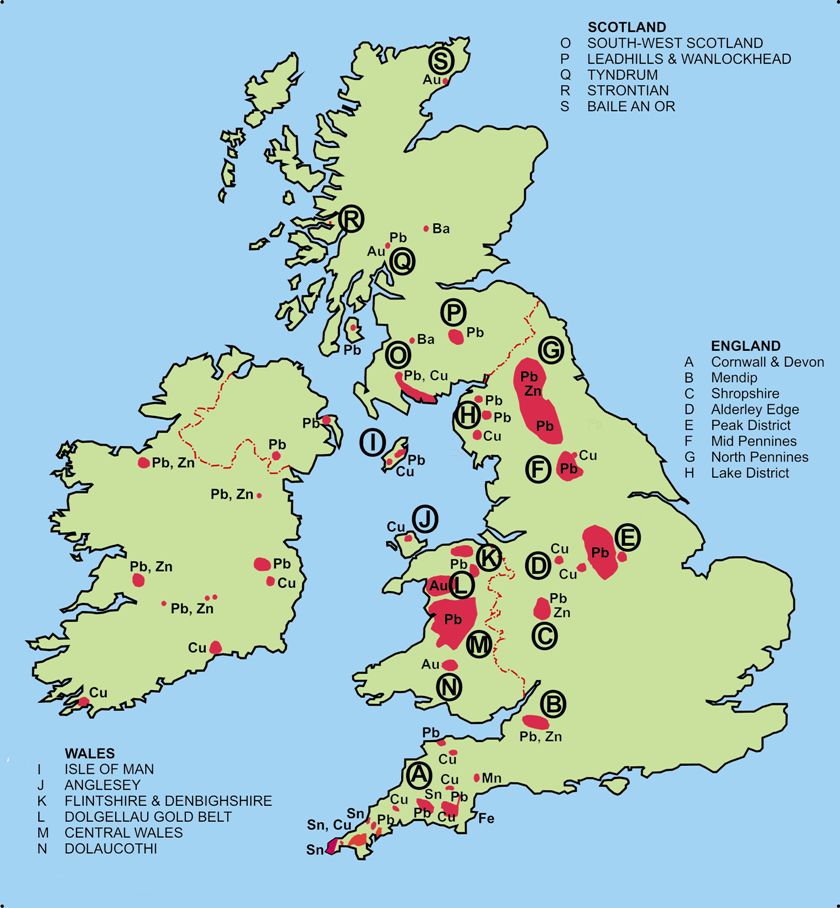
Mining Techniques and Materials: The prehistoric miners worked with mixtures of oxidised sulphidic ores, including chalcopyrite, malachite, and others, often mixed with galena in surface oxidised zones of vein deposits. They used methods such as firesetting and the use of bone or antler picks, and a collection of hafted and hand-held stone tools.
Chronological Progression of Copper Mining: The exploitation of copper resources in the British Isles is believed to have started around 2400 BC in SW Ireland at the Ross Island mine. After depletion, the search for new copper resources moved to sites in southwest Cork, the Isle of Man, and then the west coast of Britain, particularly in the mid-Wales uplands.
Abandonment and Prospection: By 1600-1500 BC, most of the mines in the region had been abandoned. This was likely due to the exhaustion of easily accessible ores and the increasing depth of workings leading to drainage issues. Climate deterioration and increased precipitation might have contributed to this as well.
Mining Continuation: Some mines, such as Great Orme in Wales, continued to be exploited into the Middle Bronze Age (c.1500-1400 BC) and even into the Late Bronze Age and Iron Age. This indicates a long history of copper mining in certain regions.
Absence of Smelting Sites: Despite evidence of mining activity, no clear evidence of smelting sites associated with Early Bronze Age and Middle Bronze Age mines have been found. The absence of smelting evidence poses questions about the nature of metal production in these regions.
Importance and Future Research: The research on prehistoric copper mining in Britain is essential. Future research should address questions about the production figures of copper from these mines, the amount of recycling and metal import, and the presence of undiscovered sites
1. Pigments
Mineral pigments are naturally occurring coloured substances derived from minerals and rocks. These pigments were used by prehistoric societies for various purposes, including cave painting, body adornment, and the creation of art and artefacts. Here’s more information about mineral pigments and their use in prehistoric times.
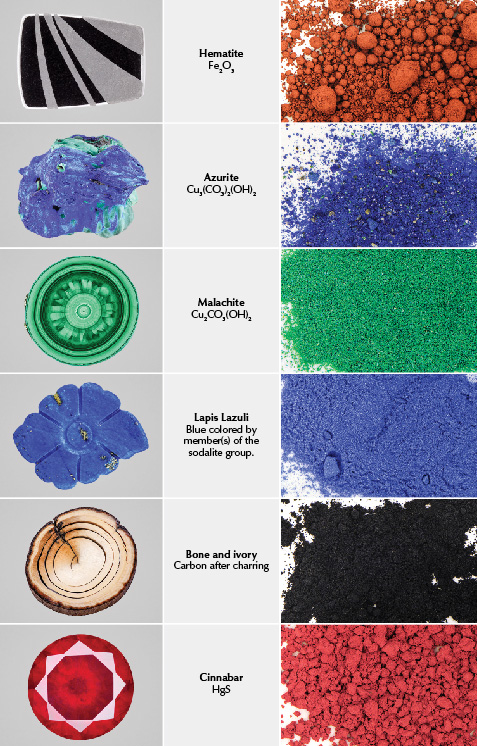
Types of mineral pigments: Mineral pigments come in various colours, each originating from different minerals. Some common examples include:
Red and yellow ochre: Derived from iron oxides and clay minerals.
Black charcoal: Made from charred wood or other organic materials.
White chalk: Composed of calcium carbonate or calcium sulfate.
Green malachite: A copper carbonate mineral with a vibrant green colour.
Blue azurite: A copper carbonate mineral with a deep blue hue.
Brown and black manganese dioxide: Used for darker shades.
Sources: Prehistoric people sourced mineral pigments from local geological deposits. They often grind or crush the minerals to create fine powders that could be mixed with water, animal fat, plant sap, or other binders to make paint or pigment mixtures.
Cave paintings: One of the most famous uses of mineral pigments in prehistoric times is for cave paintings. Ancient humans, such as those from the Paleolithic and Neolithic periods, painted intricate and vivid images on cave walls using mineral pigments. The exact purposes of these paintings are not fully understood, but they likely served religious, ritualistic, or storytelling functions.
Body adornment: Prehistoric people also used mineral pigments for body painting and personal adornment. They would apply pigments to their bodies for ceremonies, rituals, tribal identification, or simply as a form of expression.
Art and artefacts: Mineral pigments were used to create various prehistoric art and artefacts, including pottery, sculptures, and tools. Dyes were often applied to these items to add colour and decoration.
Symbolism and cultural significance: The choice of colours and the use of certain mineral pigments might have held symbolic and cultural importance for prehistoric societies. For example, red ochre may have represented blood or life force, while black pigments could have been associated with death or mourning.
Preservation: Using mineral pigments in prehistoric art has allowed these ancient creations to survive for thousands of years. Many cave paintings and artefacts have been remarkably well-preserved, offering valuable insights into the lives and beliefs of prehistoric people.
Using mineral pigments in prehistoric times showcases the early humans’ creativity and resourcefulness in harnessing the natural world to express themselves artistically and communicate their ideas and beliefs across generations.
Overall, the archaeological investigations into prehistoric copper mining in Britain provide valuable insights into the metal production processes and economic and environmental factors that influenced mining activities during that period.
Prehistoric Times
Alderley Edge, located in Cheshire, England, has been hypothesised to have been a site of prehistoric extraction of mineral pigments, including malachite, azurite, manganese wad, iron oxide, and pyromorphite. The extraction may have occurred during the Mesolithic to Early Bronze Age, but no clear archaeological evidence exists to confirm this. The suggested locations for this activity are the soft Bunter (Upper Mottled Sandstone) at Pillar Mine and the interbedded mudstone horizons containing azurite nodules at Devil’s Grave and Engine Vein. The presence of Mesolithic flint scatters on the edge, possibly indicating occupation sites, is coincidental with the mineral outcrops.
In the Forest of Dean, Gloucestershire, there is potential early evidence for iron ochre pigment extraction. Rare small hand-held cobblestone implements used as crushing stones, presumably for hematite, have been found within old ironstone mines, such as Clearwell Caves, which likely have medieval or even pre-medieval origins. Hammerstones recovered from old scowls in a quarry at Drybrook on the east side of the Severn also show evidence of grooving for hafting and crushing stones. Nearby cup-marked hollows in bedrock have been interpreted as anvils or mortars for crushing hematite. While no specific date has been ascribed to these workings, it has been suggested that they could be Bronze Age in origin.
In Exmoor, specifically at Roman Lode near Simonsbath, evidence of Early Bronze Age activity has been found, including a large hearth and a deposit containing anthropogenically smashed quartz. This location is associated with the surface outcrop of a hematite lode exploited historically for iron. Although the excavators considered the possibility of copper exploration, hematite ochre pigment exploration is also a plausible explanation for this evidence.
In Cumbria, two polished stone celts were discovered in old hematite workings at Stainton, Barrow-in-Furness, during the 1870s. The significance of this finding is unclear, but it raises the question of whether it could be evidence of associated mining, possibly for pigment.
Roman Period
Pot Shaft at Engine Vein in Alderley Edge might have been worked for a blue pigment made from azurite nodules found in a mudstone horizon within the Engine Vein Conglomerate. Malachite and azurite disseminated within the softer underlying Bunter sandstones could have been extracted for pigments. A similar Roman mine in Germany, Wallerfangen-Saar, was worked for azurite pigment (Egyptian Blue) during the 2nd-4th centuries AD, using a parallel shaft and level construction method. However, the connection between Pot Shaft and pigment extraction is speculative, and more research is needed to confirm this possibility.
2. Copper
Copper is a chemical element with the symbol Cu and atomic number 29. It is a ductile metal with excellent thermal and electrical conductivity. Copper is found naturally in the Earth’s crust and has been used by humans for thousands of years due to its beneficial properties.
In prehistoric times, copper played a crucial role in the development of human civilisations. Here are some ways copper was used during that era:
Tools and weapons: Prehistoric people discovered that copper could be easily shaped into tools and weapons through hammering and casting. Copper tools were used for cutting, digging, and shaping materials. Additionally, early humans used copper to create simple weapons such as knives, spearheads, and arrowheads.
Ornaments and jewellery: Copper’s attractive reddish-brown colour made it a desirable material for decorative items. Prehistoric societies used copper to create decorations and jewellery, often associated with status, wealth, and social significance.
Containers and vessels: Copper’s malleability allowed prehistoric people to create containers and receptacles for storing food, liquids, and other materials. Early copper vessels helped in food preparation, storage, and transportation.
Ritual and ceremonial objects: In prehistoric societies, copper artefacts held cultural and ritual significance. They were used in religious ceremonies, burial practices, and other important rituals.
Currency and trade: As civilisations developed, copper became one of the earliest forms of money and played a role in trade and economic systems. It was used as copper ingots or shaped into standardised forms for exchange.
Metalworking advancement: The use of copper marked an essential step in developing metalworking skills. It laid the foundation for the discovery and use of other metals like bronze, an alloy of copper and tin that played a significant role in the Bronze Age.
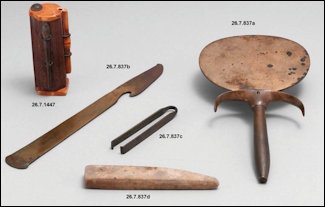
It is essential to note that the prehistoric use of copper predated the development of smelting techniques that extract copper from its ores. Early humans often found native copper, which is copper in its pure metallic form, in various places, making it relatively easy to work with compared to copper ores.
The knowledge and utilisation of copper significantly impacted prehistoric cultures, allowing for technological advancements, improved living conditions, and the rise of more complex societies. Copper’s role in shaping prehistoric civilisations eventually led to the transition from the Stone Age to the Copper Age and beyond, influencing the trajectory of human history.
Prehistoric Times
The Southwest (Cornubian) orefield of Cornwall and Devon, known for its rich mining history, has not provided conclusive evidence for prehistoric hard-rock metal mining or copper extraction during the Bronze Age. Circumstantial evidence of stone mining tools can be found in some collections, but it is challenging to distinguish them from tools used for later tin ore crushing. However, a significant find was the analysis of Early Bronze Age copper artefacts that suggested a source within an ore body associated with the Cornubian granite batholith, possibly the St. Austell intrusion. While local copper-alloy metalworking has been identified at Middle Bronze Age settlements, there is no evidence of primary smelting in the region.
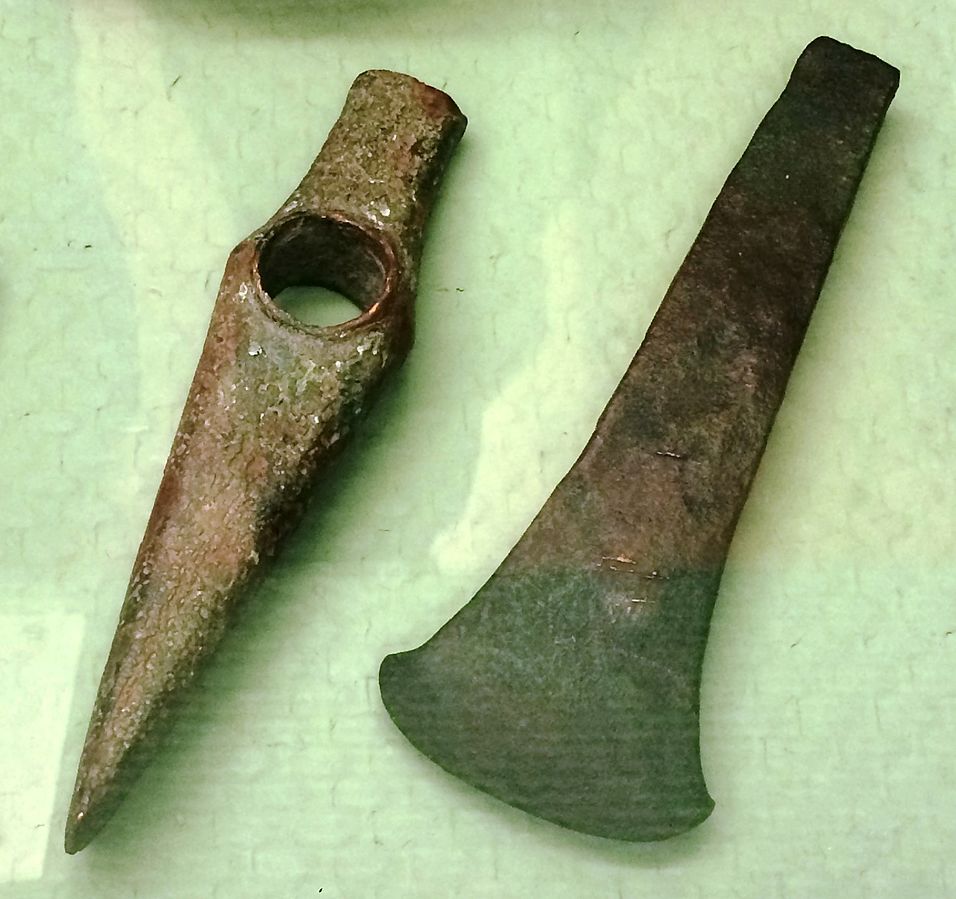
The Isle of Man has yielded evidence of prehistoric prospection for copper. Hammerstones associated with copper mineralisation were found on the Langness peninsula and other locations around the island’s southern tip. Additionally, Copper Age/Early Bronze Age metalwork from the Isle of Man shows affinities with Irish, early Welsh, and Scottish axes, indicating connections with metalworking in neighbouring regions.
Alderley Edge has provided evidence of Early Bronze Age copper mining. Fieldwork and excavation have revealed a prehistoric mining landscape dating back to approximately 1888-1677 cal BC. Stone tools and artefacts, including an oak shovel and hammerstones, were discovered in the area. Reconstructions of primitive smelting operations were undertaken at Alderley Edge, suggesting the possibility of local smelting during the Early Bronze Age.
The Ecton Copper Mine in Staffordshire has provided evidence of Early Bronze Age copper mining. Surface excavations and underground exploration revealed stone hammers, bone tools, and antler picks dating back to approximately 1880–1680 cal BC. The evidence suggests the existence of a second locality for Bronze Age copper mining in England.
Llanymynech Ogof, located on the border between England (Shropshire) and Wales, is a labyrinthine system of mine passages. Although initially thought to be a Roman mine due to the discovery of Roman coins and a coin hoard, it is now believed to be of Iron Age or earlier. Antler pick tools, a round hammerstone, and evidence of mining or smelting-related copper pollution have been found underground. Excavations at a nearby site, Downgay Lane, uncovered a Middle Iron Age copper smelting site with furnaces and evidence of copperworking dating back to approximately 275–10 BC.
Overall, while some regions in the British Isles have yielded evidence of prehistoric copper mining and metalworking, the evidence is limited, and more research is needed to fully understand the extent and nature of prehistoric copper extraction and metalworking practices in the region.
Roman Period
The discovery and excavation of Pot Shaft primarily represent the Roman presence at Alderley Edge. This site is a 12-meter-deep abandoned Roman shaft and cross-cut level found in March 1995. The excavation, undertaken in October 1997, revealed a 2m x 2m square shaft that connected to the open stope of Engine Vein. The style of coarse pick-work on the walls of Pot Shaft is reminiscent of Roman workings witnessed in other mining sites, such as the Dolaucothi gold mine in South Wales.
While the age of the in situ timbers found within the base of Pot Shaft does not definitively rule out a pre-Roman Iron Age date, the mining style suggests an early Roman period. Radiocarbon dating of the basal sawn oak timber produced a date range that could correspond to the Early Roman period (mid-1st century AD).
The extent of Roman mining activity at Alderley Edge seems relatively limited. There is no evidence of adit levels or extensive surface spreads of Roman mine spoil. The absence of Roman pottery or other artefacts also suggests that the Roman activity at Engine Vein was likely short-lived, possibly lasting over 20 years.
Pot Shaft’s mining use could have been under military control, potentially involving the XX Legion based in Chester. However, the evidence points to a small-scale operation, likely aimed at sampling the unexploited vein lying beneath the earlier Bronze Age workings.
Pot Shaft is the most complete and archaeologically excavated Roman mining feature in England found at Alderley Edge. The Roman activity at the site appears to have been limited and relatively short-lived, primarily focused on the exploration and potential extraction of minerals from Engine Vein.
3. Tin
Tin is a chemical element with the symbol Sn and atomic number 50. It is a silvery-white metal known for its low toxicity and ability to resist corrosion. Humans have used tin since ancient times, and its use played a crucial role in developing prehistoric societies. Here’s how tin was used in prehistoric times:
Alloying with copper to create bronze: One of the most significant uses of tin in prehistoric times was its alloying with copper to produce bronze. Bronze is an alloy composed mainly of copper, tin, and sometimes other metals like zinc. Adding tin to copper resulted in a more robust and durable metal than copper or tin alone. This marked a significant technological advancement, leading to the Bronze Age and revolutionising various aspects of prehistoric cultures.
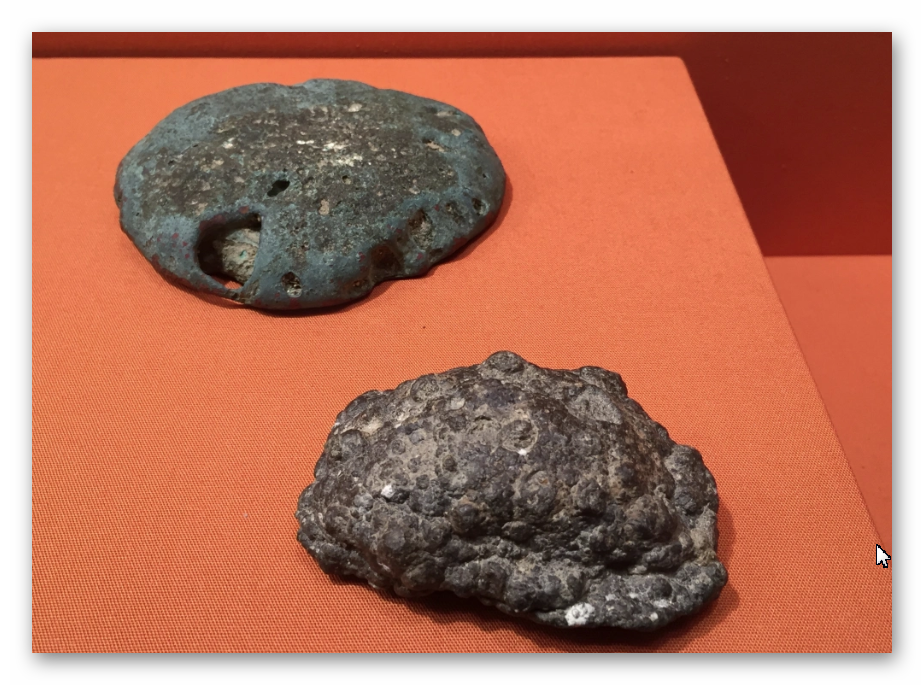
Bronze tools and weapons: The development of bronze allowed prehistoric societies to produce superior tools and weapons. Bronze tools, such as axes, adzes, chisels, and knives, were widely used for agriculture, construction, and craftsmanship. Bronze weapons, including swords, spears, and arrowheads, provided military advantages and influenced the nature of warfare.
Ornaments and decorative items: Tin, like copper, was also used to create ornaments, jewellery, and decorative items. Bronze artefacts were often associated with status, wealth, and social significance, and they were used for personal adornment and in religious and ceremonial contexts.
Containers and vessels: Bronze’s durability and resistance to corrosion made it suitable for crafting containers and receptacles for storing liquids and other materials. Bronze vessels were used for various purposes, including food storage, cooking, and ceremonial offerings.
Coins and currency: With the discovery of bronze, societies began using metal objects as a form of currency and a means of exchange in trade. Early bronze objects, such as small ingots or standardised shapes, were used as early forms of money.
Art and sculpture: Bronze became a favoured material for creating art and sculptures during prehistoric times. Skilled artisans crafted bronze statues and figurines that depicted gods, heroes, animals, and other significant subjects.
The widespread use of bronze in prehistoric times marked a significant advancement in metallurgy and profoundly impacted the development of human civilisations. The Bronze Age, characterised by the general use of bronze tools and artefacts, laid the foundation for more complex societies and increased trade and cultural exchange.
It’s important to note that while the exact timeline of the Bronze Age varied across different regions, its emergence generally marked a period of significant progress and cultural transformation in prehistoric societies.
Prehistoric Times
During the Bronze Age, it is highly probable that alluvial tin (cassiterite) was exploited from tin-rich areas in Cornwall and Devon. Although the evidence of local extraction in the Early Bronze Age is limited, some findings indicate tin smelting activities. For example, seven fragments of tin slag were found associated with a dagger within the basal layer of turves of the Caerloggas I barrow at St. Austell, representing inefficient smelting of local tin carried out around the 16th century BC. Additionally, cassiterite pebbles were discovered at the Bronze Age settlement of Trevisker.
Penhallurick (1986) suggests that over 40 prehistoric artefacts recovered from later tin streaming activities could be objects left by Bronze Age tinners, as the same tin gravels were likely to have been worked again. Some tin streams around the margins of the source granites, particularly those around St. Austell, are considered to have been worked in prehistory.
The exploitation of tin in the Southwest and its trade with the Continent likely started in the Late Iron Age and possibly earlier. Classical sources refer to the Cassiterides (islands) and to Ictis, which is believed to be a trading site associated with tin. It is suggested that such tin exploitation and trade dates back at least to the Late Bronze Age, considering the presence of trading sites around the coast.
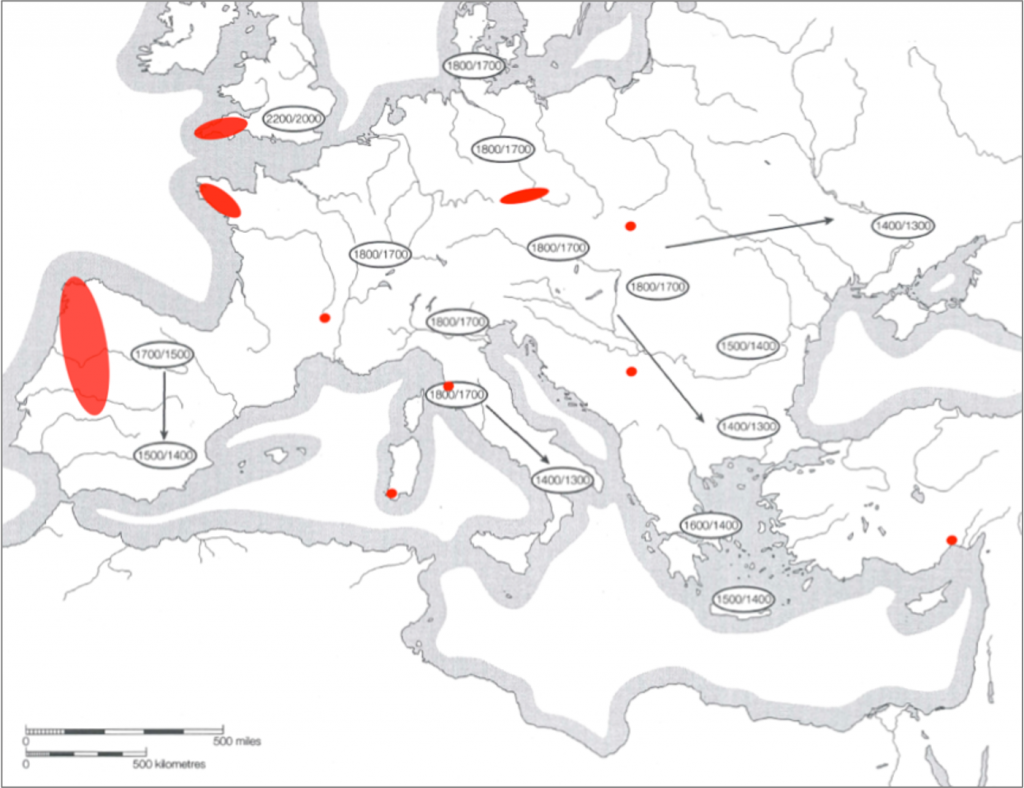
Excavations at Chun Castle revealed evidence of tin smelting in the pre-Roman Iron Age (3rd-2nd century BC), indicating local exploitation of tin. Similar sites showing evidence of tin smelting and likely tin exploitation during the Iron Age include Trevelgue and the Iron Age settlement of St. Eval.
Roman Period
Tin exploitation from placer deposits continued during the Roman period. Ingots of tin recovered from Cornish sites, such as Trethurgy, which were stamped with helmeted heads, suggest Roman involvement in tin trade. The recovery of plano-convex tin ingots from Bigbury Bay in South Devon dating from the Late Roman period (4th-5th century AD) further supports the continuation of tin trade during this era.
Roman artefacts associated with tin workings have been found at sites like Pentewan in St. Austell and Treloy in St. Columb Minor. However, due to intense and focused placer tin exploitation in recent centuries, physical remains of prehistoric or Roman tin workings of this type are unlikely to have survived. Recent examination of Devon’s river sediments away from the moorland has provided radiocarbon dates suggesting that wastes from tin working processes on Dartmoor were deposited in the rivers during the Roman and post-Roman periods.
4. Gold
Gold is a chemical element with the symbol Au and atomic number 79. It is a dense, soft, yellow metal known for its beauty, rarity, and resistance to corrosion. Humans have treasured gold for millennia and have played a significant role in shaping prehistoric societies. Here’s how gold was used in prehistoric times:
Adornment and jewellery: One of the primary uses of gold in prehistoric times was personal decoration and jewellery. Early humans discovered the allure of gold due to its natural beauty and rarity. Gold was fashioned into jewellery, such as necklaces, bracelets, rings, and earrings, to enhance personal appearance and symbolise wealth and status.
Religious and ceremonial objects: Gold’s intrinsic value and symbolic significance led to its use in religious and formal contexts. Gold artefacts were used in religious rituals, temple decorations, and as offerings to gods or deities.
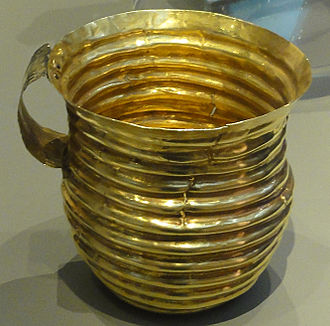
Currency and trade: Gold, like other precious metals, was an early form of currency in prehistoric trade. Its value and universal acceptance made it an ideal medium of exchange for goods and services across different cultures and regions.
Status and wealth display: Owning gold in prehistoric times was a sign of wealth, power, and prestige. Gold objects were often owned by rulers, nobles, and wealthy individuals and were displayed as symbols of social standing.
Craftsmanship and art: Skilled artisans used gold to create intricate and ornate objects, including statues, figurines, and decorative items. Gold’s malleability allowed it to be shaped into detailed forms, making it a favoured material for artistic expression.
Burial practices: Gold artefacts were sometimes buried with individuals of high status or importance. Gold objects found in burial sites from prehistoric times provide valuable archaeological insights into the beliefs and practices of ancient societies.
Symbolism and religious significance: Beyond its material value, gold was symbolic in prehistoric cultures. It was associated with the sun, divinity, immortality, and the eternal nature of the gods.
It’s important to note that while gold was used in prehistoric times, its availability was limited compared to today. Early civilisations primarily sourced gold from placer deposits, riverbeds, and surface mines. As more sophisticated mining techniques were developed over time, gold became more accessible, and its use expanded.
Gold’s allure and importance have persisted throughout human history, shaping trade, economies, and cultural practices. In contemporary times, gold continues to hold a significant role as a store of value, a medium of exchange, and a symbol of wealth and luxury.
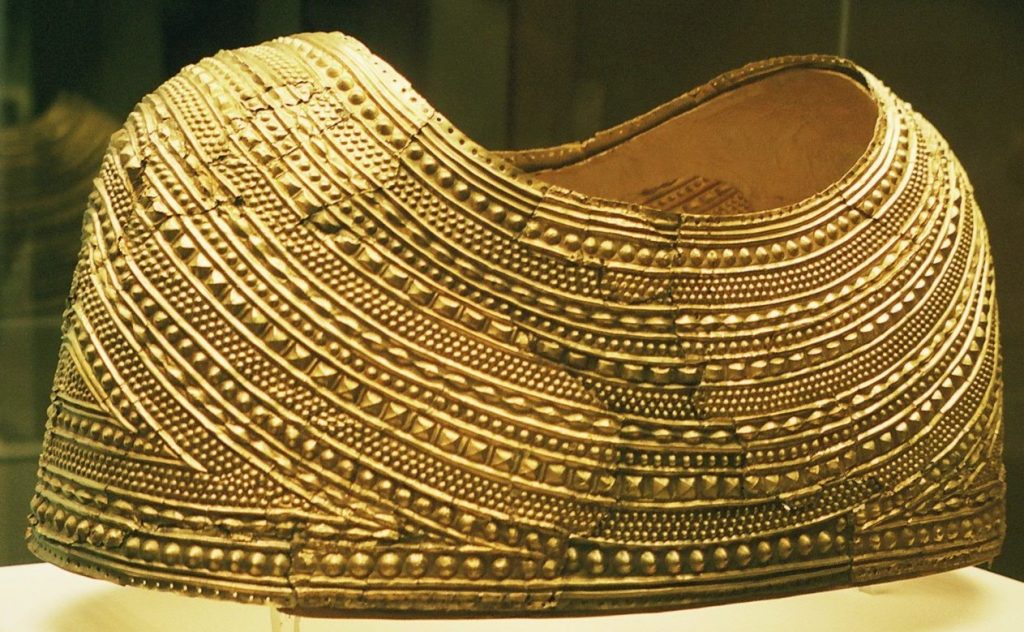
Prehistoric Times
During the Bronze Age, there was evidence of gold recovery from tin ground in Cornwall. During the historical period, Tinners regularly recovered small amounts of gold from areas such as Treloy and the Carnon Valley. While this alone is insufficient evidence to identify these sites as English Bronze Age gold sources conclusively, there is more intriguing evidence. British Bronze Age goldwork, to a significant extent, contains small quantities of tin in parts per million. However, samples of native gold from Ireland, Wales, and Scotland are either devoid or have shallow levels of tin. On the other hand, Cornish gold has been shown to contain significant amounts of tin, ranging from 25-50 ppm. Early Bronze Age gold lunulae from Harlyn Bay, Padstow, and St. Juliot have also revealed tin concentrations ranging from 50 ppm to 950 ppm.
The presence of tin in Cornish gold suggests that gold was likely produced as a byproduct of alluvial tin mining from the Bronze Age onwards, possibly in places like the Carnon Valley. Research is being conducted on the trace element composition of native gold and Bronze Age gold artefacts in Ireland to identify sources. Similar studies could be valuable in England and the rest of the UK, and analysing stable isotope ratios may also prove effective in determining the origin of alluvial gold.
Roman Period
During the Roman period, gold production in Britain was limited, but there were a few known sources of gold mining. The Romans were particularly interested in exploiting Britain’s mineral resources, including gold, for their empire.
The Dolaucothi Gold Mines, located in present-day Carmarthenshire, Wales, were one of the most significant gold-producing areas during the Roman occupation of Britain. These mines are believed to have been exploited by the Romans from around 75 AD until the end of the 3rd century AD. The Romans used advanced mining techniques, such as hushing (using water to wash away soil and expose gold-bearing rocks), open-cast mining, and deep mining to extract gold from the veins in the Welsh hills.
Clogau St David’s Mine, situated in what is now Gwynedd, Wales, was another gold mine known to have been worked during the Roman period. The Romans likely extracted gold from this mine and other nearby deposits. The Gwynfynydd Gold Mine, located near Dolgellau in Gwynedd, Wales, is known to have been a significant source of gold during the Roman period and continued to be active throughout the medieval period.
It’s worth noting that while these mines were productive during the Roman period, the overall gold production in Britain during that time was relatively modest compared to other regions in the Roman Empire, such as Spain and Dacia (modern-day Romania), where more significant and more abundant gold deposits were exploited.
The Romans used the gold from these mines for various purposes, including coinage, jewellery, religious artefacts, and offerings to temples and deities. Today, these ancient gold mines are of historical and archaeological interest, and some are open to visitors as tourist attractions.
5. Lead
Lead is a chemical element with the symbol Pb and atomic number 82. It is a heavy, bluish-grey metal known and used by humans for thousands of years. In prehistoric times, lead was used for various purposes, though its usage was not as widespread as other metals like copper, gold, and silver. Here’s how lead was used in prehistoric times:
Pigments and dyes: Prehistoric people used lead-based compounds, such as lead oxide (red lead) and lead carbonate (white lead), as pigments and dyes. These lead-based pigments were used to add colour to various materials, including cave paintings, ceramics, and textiles.
Amulets and ornaments: Lead was occasionally used to create small amulets and ornaments. Although not as common as other metals, lead artefacts have been found in prehistoric sites, suggesting their use as decorative items or talismans.
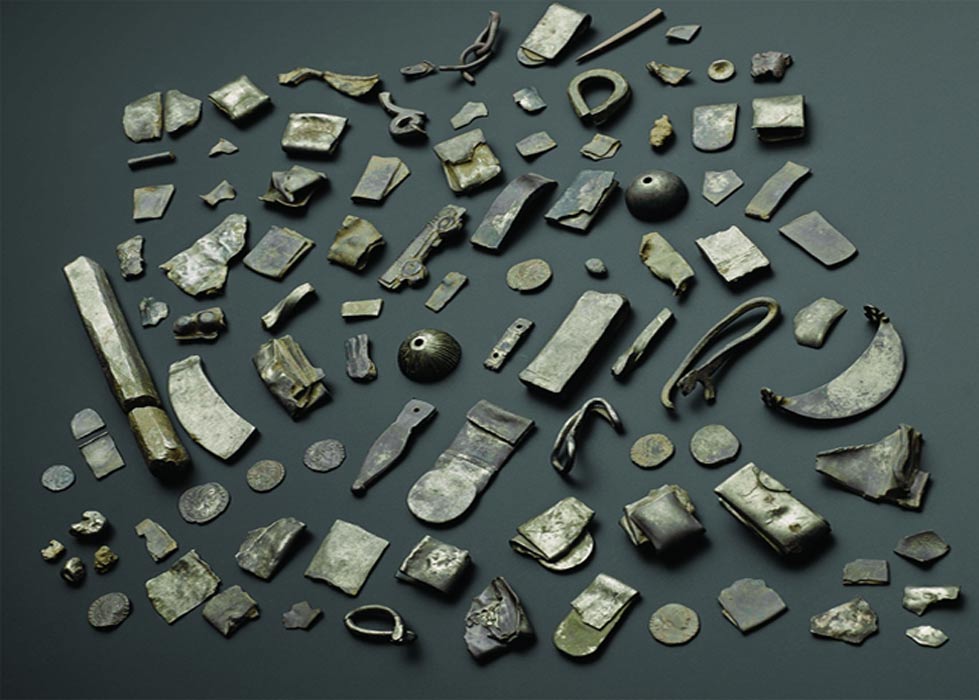
Seals and weights: In some ancient civilisations, lead was used to make seals and weights. Seals made of lead were used for stamping impressions on clay or wax, serving various administrative and commercial purposes. Lead weights were used for trade and measurement.
Water pipes: Although not as widespread in prehistoric times, some evidence suggests that ancient civilisations used lead pipes for water transportation. Lead pipes were durable and malleable, making them suitable for plumbing systems.
Glazing and pottery: Lead compounds were sometimes used in glazing pottery to achieve specific colours and effects. Lead glazes were known for their smooth finish and shiny appearance.
The health risks associated with lead exposure were not fully understood at the time, and ancient societies may have unknowingly exposed themselves to lead poisoning through the use of lead-based pigments and other lead-containing materials.
Prehistoric Times
In the Bronze Age, lead was intentionally added to tin bronze during the Acton Park (Middle Bronze Age, 1400-1300 BC) and Wilburton (Late Bronze Age, 1000-900 BC) metalworking periods in the Southwest of England. Burgess and Northover suggest that the lead was probably sourced from British locations, and stable lead isotope analysis of bronze artefacts and ores later supported the possibility of a match between Wilburton metalwork and a lead source in the Mendips, Somerset.
In the Peak District, lead use was evident during the Late Bronze Age. A socketed axe made of lead was discovered at Mam Tor, which might represent one of the earliest exploitations of lead in the region. Also, Late Bronze Age axes from Britain containing up to 15-21% lead are considered to have been sourced indigenously.
Bronze Age lead mining has also been proposed at Llanymynech on the Welsh-Shropshire border.
In the Mendips, pre-Roman (Iron Age) lead mining has been suggested at Charterhouse-on-Mendip based on finds of a 3rd-century BC Greek coin, a denarius of Julius Caesar, and Iron Age pottery from excavation trenches sampling “Roman” mining rakes on the edge of the Charterhouse Roman fortlet.
Roman Period
Lead was extensively used for various purposes, including plumbing, water management systems, coffins, lead glass, spindle weights, and alloying with tin to produce pewter. Lead compounds were also commonly used as adulterants in wine and cosmetics. Numerous Roman lead pigs have been found on routes from orefields to ports, where lead was exported to other parts of the Roman Empire.
In the Mendips, Roman mining has been confirmed at Charterhouse-on-Mendip, and other areas suggest possible Roman mining based on finds of Roman lead smelting slag and evidence of opencut mining rakes. The Matlock area is also a potential location for Roman lead mining.
There is evidence of Roman lead and silver mining at Combe Martin, Calstock, Alderley Edge, the Peak District, Shropshire, and County Durham. However, some of the evidence is circumstantial or requires further examination. The Roman economy of the South Pennines, with a focus on the lead industry, has been thoroughly explored by Dearne.
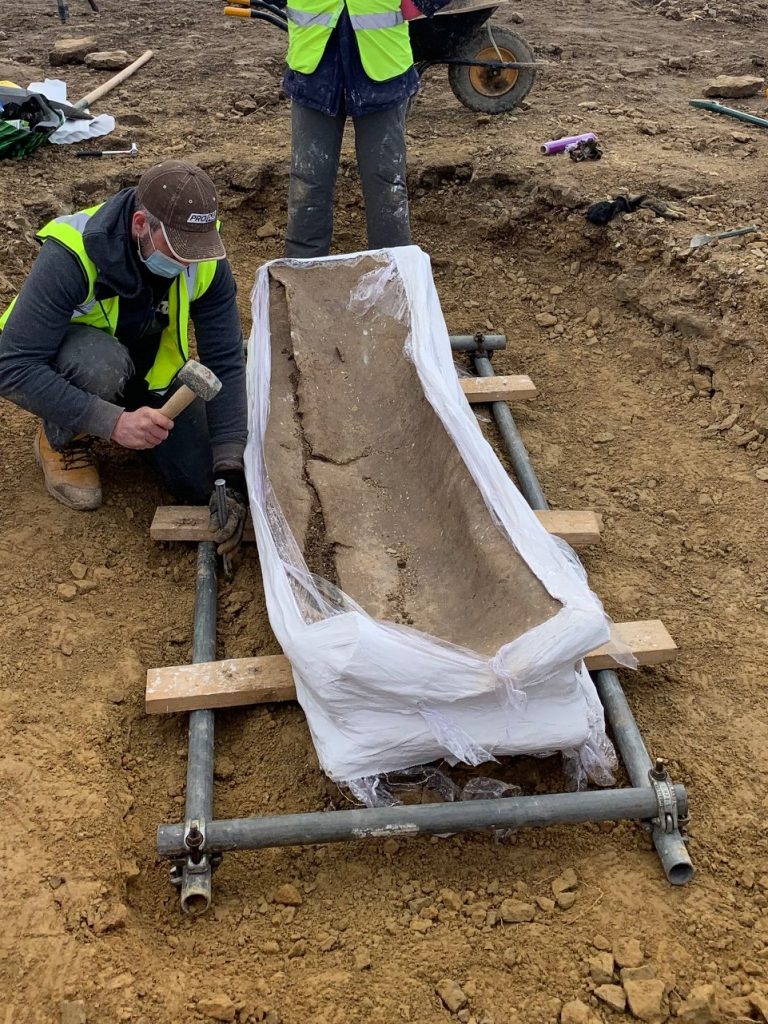
Cumbria claims that the second cohort of Nervians conducted mining during the 3rd century AD, and recent excavations in Carlisle revealed a lead smelting furnace probably linked to lead from the Alston orefield.
6. Silver
Silver is a chemical element with the symbol Ag and atomic number 47. It is a lustrous, white metal known for its excellent conductivity of electricity and heat. Humans have used silver for thousands of years, and its history dates back to prehistoric times. Here’s how silver was used in prehistoric times:
Adornment and jewellery: Silver was used for personal adornment and jewelry in prehistoric times, like other precious metals. Early humans fashioned silver into necklaces, bracelets, rings, and other ornaments to enhance their appearance and symbolise wealth and status.
Currency and trade: Silver was an early form of money in prehistoric trade. Its rarity, durability, and universal acceptance made it a valuable medium of exchange for goods and services across different cultures and regions. Silver objects were used for trade, gifts, and as a store of wealth.
Ritual and ceremonial objects: Silver’s intrinsic value and beauty led to its use in religious and formal contexts. Silver artefacts were used in religious ceremonies, temple decorations, and as offerings to gods or deities. The metal’s radiant appearance and association with the moon and water symbolised purity and spirituality.
Utensils and containers: Prehistoric societies used silver to create utensils, such as cups, bowls, and plates. Silver’s antimicrobial properties made it particularly suitable for storing food and liquids.
Art and craftsmanship: Skilled artisans used silver to create intricate and decorative objects, including figurines, statues, and other works of art. Silver’s malleability and ability to hold intricate details made it a favoured material for artistic expression.
Mirrors and reflective surfaces: In some cultures, polished silver surfaces were used as mirrors in prehistoric times. These mirrors served practical and decorative purposes.
It’s important to note that while silver was used in prehistoric times, its usage was not as widespread as other metals like copper and gold. The scarcity of silver in some regions and the difficulty in extracting and refining it limited its availability for broader use.
Silver’s value and importance have persisted throughout human history, and it continues to be treasured for its various applications in modern times. Silver is used in a wide range of industries, including electronics, photography, jewellery, and medicine, among others. It remains a valuable precious metal with a significant role in global economies and cultural practices.
Prehistoric Times
There is limited evidence of silver mining in prehistoric Britain, and it is challenging to identify specific mines that produced silver during that era. The knowledge of mining activities during prehistoric times is derived from archaeological evidence and historical accounts, but many details remain uncertain.
However, some known sources of silver deposits in Britain might have been exploited to a limited extent during prehistoric times, such as the Cumbrian region, particularly around the Lake District, which is known for its lead and zinc deposits, and silver can be found alongside these metals. It is possible that silver was extracted incidentally during the mining of lead and zinc ores in the area.
Mynydd Parys (Anglesey, Wales) or Parys Mountain, is known for its rich deposits of copper ore. While copper was the primary metal of interest, small amounts of silver could have been extracted alongside the copper during prehistoric mining.
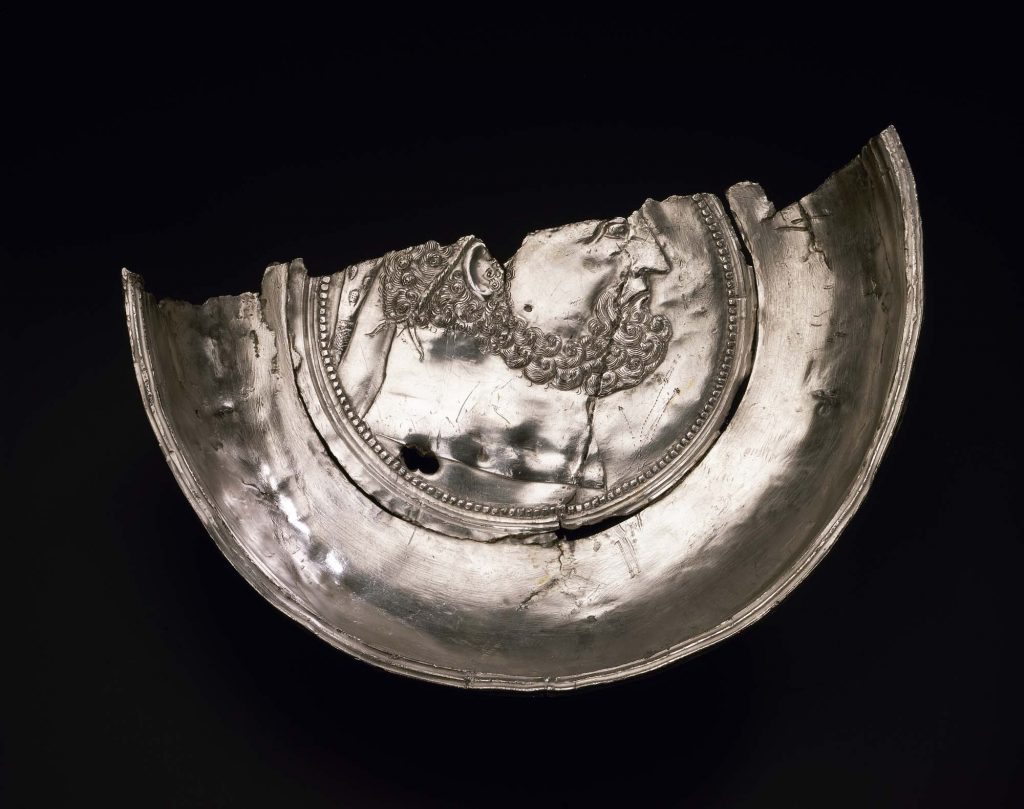
The region around Cornwall and Devon in southwestern England is known for its mining heritage, including the extraction of tin and other metals. Although no major silver mines are known in the area, silver could have been found as a byproduct of tin mining.
It’s important to note that prehistoric mining techniques were relatively rudimentary compared to later periods, and the scale of mining operations was likely small. The exact extent of silver mining in prehistoric Britain remains unclear, and much of the evidence has been eroded or obscured over time.
Prehistoric societies might have been aware of the presence of silver, but their focus on mining and metalworking was generally centred on other metals like copper, tin, and lead. Silver’s value and significance in prehistoric times were likely less pronounced than in later historical periods.
The only excavations undertaken on the Mendips (by Todd at Charterhouse) suggest the possible survival of in situ mining features and likely smelting hearths dating from the early Roman period.
Also, possible pre-Roman remains dating from the 1st millennium BC. Potentially one of the most important early Roman lead mining areas within Britain, this area is worthy of a detailed survey, soil
augering, geophysics and a better-planned and larger-scale excavation. Given the silver content of these ores, the Mendip is also an area to look for evidence of silver extraction (cupellation) from these ores (see Ashworth 1970, 15).
Roman Period
During the Roman period, silver production in Britain was limited, but there were some known sources of silver mining. The Romans wanted to exploit Britain’s mineral resources, including silver, for their empire.
Mendip Hills (Southwest England): The Mendip Hills in Southwest England, particularly around the modern-day county of Somerset, were known to be a significant source of lead and silver during the Roman occupation. Lead mining was the primary focus, but silver was often found alongside lead deposits. The Rio Tinto Mine, located in what is now Cumbria in North-west England, was another source of lead and silver during the Roman period. The mine is one of the oldest known metal mines in the world and has a long history of exploitation, including during the Roman occupation.
Mynydd Parys (Anglesey, Wales), also known as Parys Mountain, located on the Isle of Anglesey in Wales, was a significant source of copper mining during the Roman period. While copper was the primary metal of interest, some silver was also extracted alongside the copper ore.
It’s important to note that the Roman period in Britain spanned from around 43 AD to 410 AD. During this time, the extraction and production of silver were not as extensive in Britain compared to other regions in the Roman Empire, such as Spain and parts of Germany, where more significant and abundant silver deposits were exploited.
The Romans used the silver extracted from these mines for various purposes, including coinage, jewellery, religious artefacts, and offerings to temples and deities. Today, these ancient mines are of historical and archaeological interest, and some are open to visitors as tourist attractions.
7. Zinc
Zinc is a chemical element with the symbol Zn and atomic number 30. It is a bluish-white metal that is relatively rare in its pure form. In prehistoric times, zinc was not commonly used or recognised as a distinct metal due to its scarcity and difficulty extracting it from its ores. Instead, prehistoric societies would have encountered zinc in its natural form, primarily as a component of certain minerals and ores.
Zinc is found in the Earth’s crust, usually in zinc sulfide (sphalerite) or zinc carbonate (smithsonite). These zinc-containing minerals were present in some geological formations and might have been visible on the surface or in shallow deposits, where prehistoric people could have encountered them.
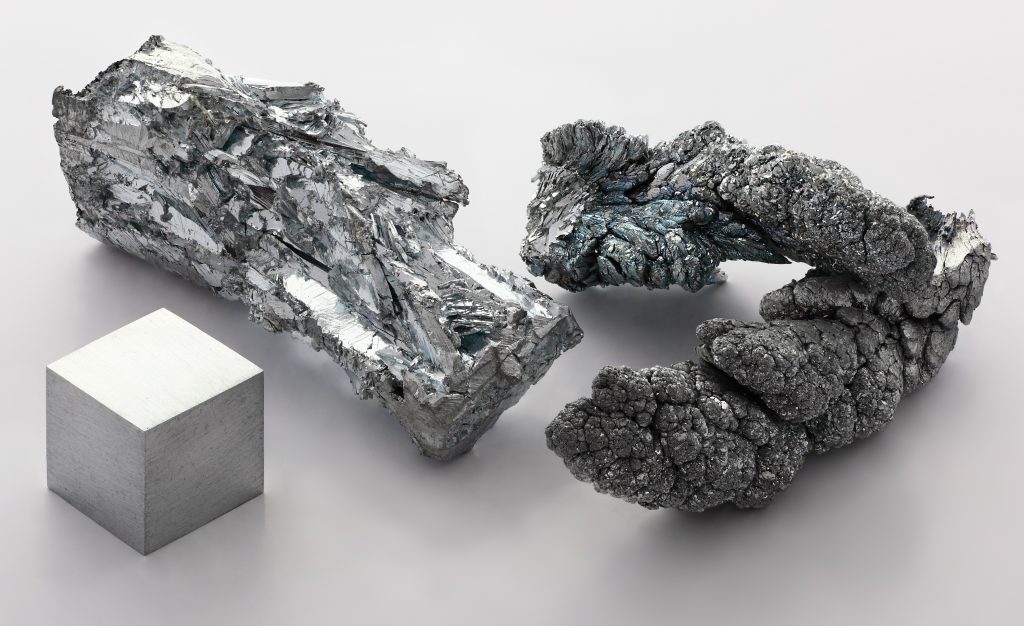
While zinc was not used as a primary metal in prehistoric times, it might have been incidentally encountered and used in small quantities as an alloying element. For example, zinc is known to occur naturally alongside copper ores, and some ancient copper artefacts have been found to contain trace amounts of zinc.
Prehistoric societies might have observed that certain zinc-containing minerals had medicinal properties, as zinc is essential for human health. However, the use of zinc-based minerals for medicinal purposes would have been based on empirical observations rather than a scientific understanding of the metal’s properties.
Overall, the knowledge and use of zinc in prehistoric times were likely minimal compared to other more accessible metals like copper, gold, and silver. Only in later historical periods did zinc become recognised as a separate metal and used more extensively in various applications.
It wasn’t until much later in history, around the 13th century, that zinc was recognised as a distinct metal and utilised in various applications. In the modern era, zinc has become an essential metal used in numerous industries, including construction, transportation, and electrical engineering, and as a crucial component in producing brass and other alloys.
Prehistoric Times
There was no direct evidence of Prehistoric mining in the Mendips or other areas in the UK. However, given the known mining of lead from these regions, it is plausible that the Romans might have also exploited the abundant near-surface calamine ores (zinc carbonate, also known as smithsonite) to produce brass using cementation.
Brass is an alloy made primarily of copper and zinc, and during the Roman period, the cementation process was used to produce brass by heating a mixture of copper and calamine in a closed vessel. The zinc vapour produced during this process would react with the copper, forming brass. While there is no direct evidence of zinc mining in the Roman period, the presence of calamine deposits near known lead mines suggests the possibility of zinc extraction for brass production.
Roman Period
During the Roman period, zinc mining was not a significant industry in the UK. Zinc is a relatively rare metal in its pure form, and its extraction and processing were not well-developed during ancient times. However, zinc occurs naturally in combination with other metals, mainly zinc carbonate (smithsonite) and zinc sulfide (sphalerite) minerals, which may have been encountered during mining for other metals like lead.
The Roman period in the UK spanned from around 43 AD to 410 AD, and the primary focus of mining was metals like lead, silver, and copper. As a distinct metal, zinc was not well-known or widely used during this era.
In the modern era, zinc mining in the UK became more prominent during the 18th and 19th centuries, especially in the Yorkshire Dales region is known for its lead mining, and zinc ore was often found alongside lead deposits. The North Pennines region, including areas like Alston Moor in Cumbria, was a significant mining area for lead, and zinc was seen as a byproduct of lead mining.
It’s essential to understand that ancient mining activities, including those during the Roman period, were often on a smaller scale compared to later historical periods. The full extent of mining for specific metals in Roman Britain remains a subject of ongoing archaeological research and investigation, so this may change as more excavations are undertaken.
8. Iron
Iron is a chemical element with the symbol Fe and atomic number 26. It is a metal that is abundant in the Earth’s crust and is the most widely used metal in the world. Humans have used iron for thousands of years, and its history dates back to prehistoric times. Here’s how iron was used in prehistoric times:
Tools and weapons: One of the most significant uses of iron in prehistoric times was to produce tools and weapons. Early humans discovered that iron could be heated and shaped into implements, including axes, knives, spears, and other cutting and piercing tools. Iron tools were more durable and efficient than those made from earlier materials like stone or copper, leading to significant technological advancements.
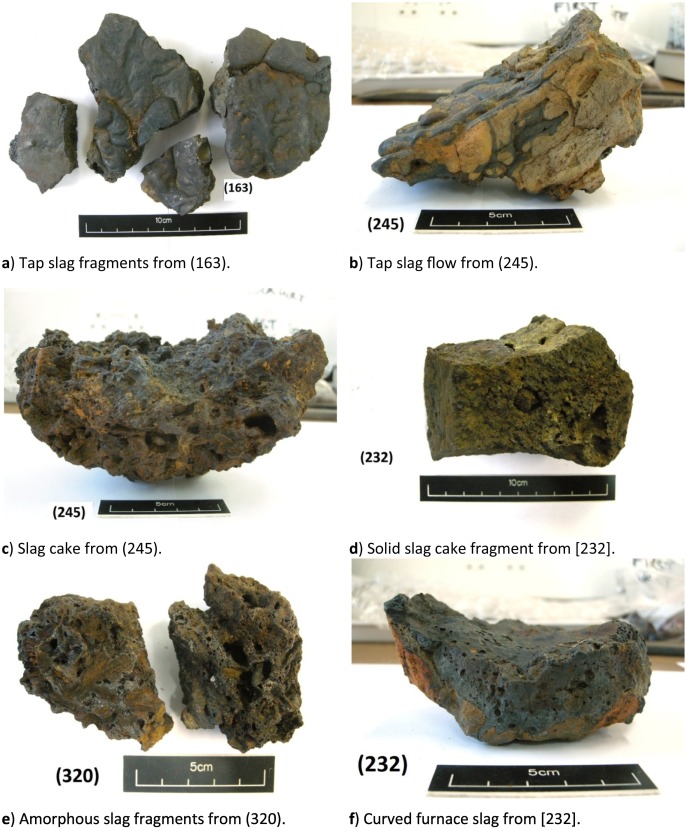
Agriculture: Iron tools revolutionised agriculture during prehistoric times. Iron ploughs, hoes, and other implements made tilling the soil and farming more efficient, increasing food production and developing settled agricultural communities.
Artefacts and ornaments: Iron was occasionally used for crafting decorative items and decorations during prehistoric times. While not as common as copper or gold, iron artefacts have been found in prehistoric archaeological sites, suggesting their use for artistic and symbolic purposes.
Building materials: Prehistoric societies used iron in construction and building projects. Iron nails, hinges, and other fasteners were employed to join wooden structures and create more durable and stable buildings.
Trade and commerce: Iron ingots and bars were sometimes used as currency or as trade items in prehistoric societies. As ironworking techniques spread, iron objects became valuable commodities for exchange.
It’s important to note that the widespread use of iron in prehistoric times marked a significant transition from the Stone Age to the Iron Age. The Iron Age, which followed the Bronze Age, saw the increasing use of iron for tools, weapons, and various artefacts, leading to transformative changes in human societies.
Prehistoric ironworking involved smelting iron ore in furnaces, a process requiring high temperatures and skilled craftsmanship. As iron became more widely available, it played a crucial role in developing civilisations, contributing to the rise of empires and influencing the course of human history.
Prehistoric Times
In the archaeological record, evidence of iron extraction is primarily found in the remains of smelting hearths. The original ore sources are identified based on samples found near these hearths. The development of iron extraction in Britain evolved from the bowl furnace to the shaft furnace and then the slag pit furnace (Tylecote 1986).
Iron smelting found at sites distant from known iron ore sources, such as Mucking in Essex and Hevingham in Norfolk, indicates either ore movement or bog iron’s once widespread occurrence. Geological origins of iron ore in Britain are diverse, including vein hematite and goethite (found in Furness, Cumbria; Brendon Hills, Somerset; and Forest of Dean), blackband ironstones (siderite) found in coalfield areas, Wealden ironstones (siderite) from Sussex, Hampshire, and Surrey, as well as Cretaceous Greensand ores like Carstone in Bedfordshire and Upper Greensand ores in Devon.
Prehistoric Iron ore can also be found in the abundance in following counties:
Dorset: Locally collected iron ore was extracted from cliffs at Hengistbury Head and smelted between 400 BC and AD 50 (Bushe-Foxe 1915). Similar evidence of locally sourced iron ore and smelting was found in Gussage All Saints (Wainwright et al. 1979).
Wiltshire: Iron ore was smelted at All Cannings Cross, Wiltshire, between 400-250 BC, using ore from the local Lower Greensand, likely from Seend (Cunnington 1923).
Somerset: A short rake (opencut) at Charterhouse-on-Mendip, examined by Todd in 1996, contained hematite ore rather than lead. Denarii of Julius Caesar (48 BC) and some Iron Age pottery were recovered. Other potential Iron Age mineworkings are poorly explored and often undated, including sites at Kitnor Heath on Exmoor and Colton Pits in the Brendon Hills (L Bray pers comm).
Devon: An Early Iron Age smelting site at Kestor near Chagford in Devon, dated just after 400 BC, may have reduced a local bog iron ore (Tylecote 1986). There is some debate about the date of the site, and additional C14 dating indicates it may be from the 6th century AD. The slag at Kestor is believed to be associated with trial working of ores that didn’t succeed rather than regular production (Peter Crew’s observations).
Cornwall: One of Cornwall’s earliest iron extraction sites is the promontory fort of Trevelgue Head. Between the Mid and Late Iron Age, approximately 1.5 to 2.3 tonnes of iron were produced from a narrow lode running through the headland (see Dungworth in Nowakowski 2011). The scale of Iron Age extraction here was limited, making between 10 and 20 kg of iron per year, suggesting short-lived and localised exploitation.
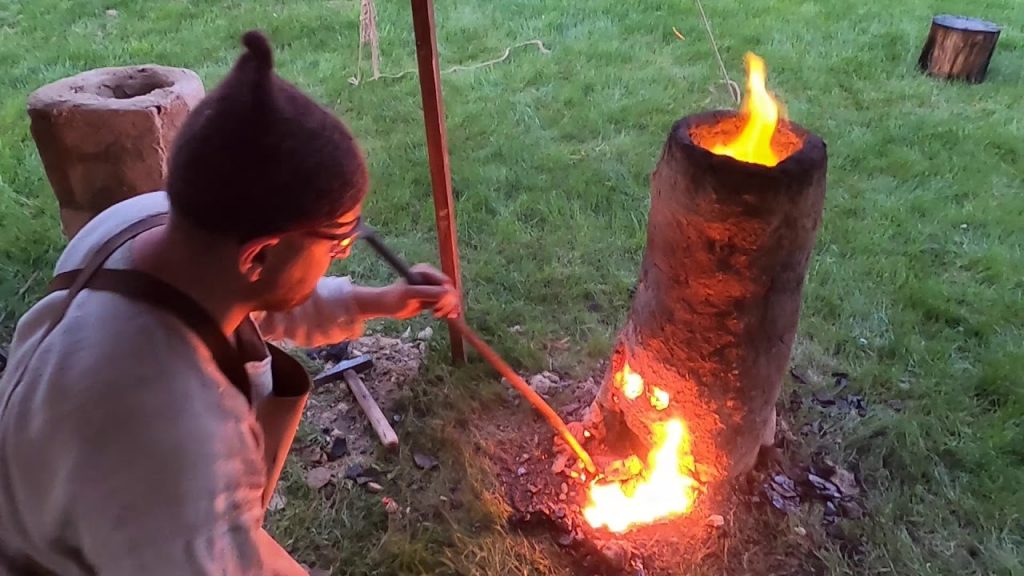
Surrey: At Brooklands near Weybridge, slag weighing up to 44 kg was found as part of the waste from slag-tapping furnaces operated between the Early and Late Iron Age (from the 5th century BC to 1st century AD). The ore source was likely high-quality sideritic ironstone from nearby St. George’s Hill. At Purberry Shot near Ewell, furnace bases and a bloom dating from 200 BC – AD 150 represent a small industry using local iron ores from the Wadhurst Clay (Lowther 1946).
Sussex: Pre-Roman iron smelting (190-80 BC) in shaft furnaces with slag-tapping pits has been identified at Broadfield near Crawley in Sussex, using local Wealden iron ores (siderite). Other Wealden Roman furnaces have been found in the area, such as at Crowhurst Park, Bardown, and Chitcomb (Tylecote 1986).
East Anglia: Iron smelting and ironworking have been found at recently excavated fenland edge Iron Age settlements, like Bradley Fen, Cambridgeshire, possibly exploiting local bog iron ores or Northamptonshire ironstone (Fincham 2004).
Northamptonshire: The settlement at Hunsbury contained pits with significant amounts of iron slag, suggesting smelting operations using local Northamptonshire ironstone. Other Iron Age furnaces have been found at Wakerley (Tylecote 1986). At Priors Hall, Corby, excavations in 2006 revealed seven slag-tapping furnaces dating to the Late Iron Age, along with pottery and tuyere fragments. The local Northamptonshire ironstone was likely smelted, sourced from the area of Rockingham Forest.
East Yorkshire: The Middle Iron Age ‘Arras Culture’ around 300 BC, linked to important chariot burials and the Hasholme log boat excavation, was associated with one of Britain’s most significant prehistoric iron industries. The iron industry appears to be based on extensive deposits of bog iron ore within the coastal Foulness Valley south of Holme, Humberside. Furnaces and significant iron slag quantities from the smelting of sandy bog iron ores have been excavated at Whelham Bridge, Yorkshire (Halkon & Millet 1999).
Northern England: Early Iron Age furnaces (7th-6th century BC) have been found at West Brandon in Durham and at Roxby in Cleveland, exploiting the local Cleveland iron ore.
Roman Period
Iron can also be seen to be mined during the Roman period in the following counties:
Cornwall: Restormel Roman Fort is close to a critical iron vein called the Restormel iron lode.
Devon: Early iron extraction pits can be seen in the Blackdown Hills, with some smelting sites identified from both the Saxon and Roman periods. Pottery dating from the second half of the 1st century AD suggests Roman military control or supervision of iron exploitation, possibly centred on the legionary fortress at Exeter (Griffith & Weddell 1996). Roman-era iron ore similar to that from the Blackdowns was discovered during the excavation of the Roman fort at Bolham, Devon (Maxfield 1991).
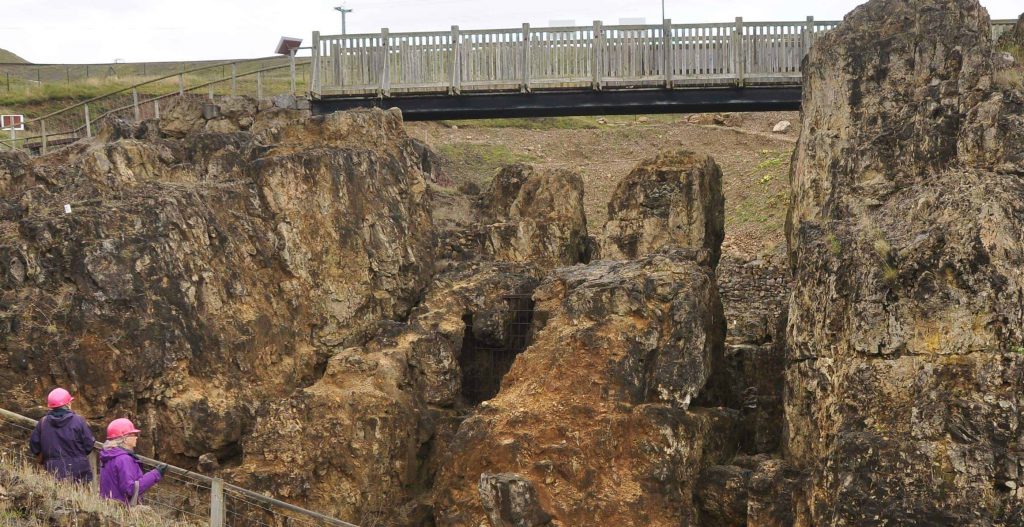
Exmoor: Iron production increased from the beginning of the 2nd century AD, reaching substantial levels in sites on the southern fringes of Exmoor, such as Sherracombe Ford and Brayford. More recently, a Late Roman smelting site has been identified at Blacklake Wood as part of the Exmoor Iron Project (ExFe) led by Gill Juleff at the University of Exeter. The source of much of the Roman iron smelting in this area is believed to be ‘Roman Lode’ at Burcombe near Simonsbath, which was an anciently worked lode of goethite (Fletcher et al. 1997).
Somerset: Evidence of Roman iron ore extraction at outcrop has been found at Treborough and Luxborough. Roman exploitation of the hematite ores of the Brendon Hills has been suggested at Colton Pits, although no datable evidence is available (L Bray pers comm). Samian pottery scatters have been found near bloomery slag heaps at Clatworthy Reservoir.
Gloucestershire: At Lydney, a minor underground working of iron ore (goethite) was discovered, working a band of ferruginous marl, and later sealed by a 3rd-century AD hut (Scott-Garrett 1959).
Forest of Dean: Scowles, ancient open-cast iron ore workings, are relatively common in the Forest of Dean. Some of these are likely Romano-British in origin, as indicated by finds of pottery and coins. Puzzle Wood near Coleford is considered one such Romano-British scowle working (Blick 1991).
Northamptonshire: Large numbers of smithing furnaces were found at Corstopitum (Roman Corbridge), but little evidence of smelting in the form of slag suggests that the Roman military might have relied on British smelters. However, evidence of domestic iron smelting within this iron-producing region, particularly in 2nd–3rd-century villas such as Great Weldon, has been found (British Archaeology Feb 2008). The Northamptonshire ironstone was worked from shallow surface outcrops using open-cast. Traces of these workings within the Northamptonshire orefield have been found at Oundle and Laxton (Taylor and Collingwood 1926).
Lincolnshire: Roman iron smelting remains have been found at Pickworth, Bagmoor, Costerworth, and Thealby. The smelting locations lie within the area of iron mining and outcrops of the Northants ironstone (Cooper-Key 1896).
Norfolk: Extraction pits at Ashwicken obtained nodular iron ore from the Lower Greensand (carstone) horizon, likely using locally constructed tree-trunk pattern-moulded furnaces for immediate local smelting. The North Norfolk site at Hevingham also suggests local smelting, with large slag cakes in the area.
Sussex: Wealden iron ore (nodular siderite and occasionally limonite) was extracted using pits, with Roman furnaces charged with a mixture of siderite and oak charcoal. The Wealden iron ore source was typically the Wadhurst Clay exposed within the immediate vicinity. Other Wealden Roman furnaces were found at Cow Park and Pippingford, Hartfield, as well as at Holbeanwood and Broadfield near Crawley (Cleere 1970 and Tebbut and Cleere 1973). The Wealden Roman iron production has been reviewed by Hodgkinson (1999).
Northern England: Both ore and slag are associated with smelting remains at the Roman fort of Templebrough near Rotherham, Yorkshire, while the fort of Galava at Ambleside produced evidence of the smelting of local bog iron ores (Tylecote 1986).
9. Coal
Coal is a combustible black or brownish-black sedimentary rock composed chiefly of carbon and other elements such as hydrogen, sulfur, oxygen, and nitrogen. It forms from the remains of ancient plants that accumulated and were subjected to heat and pressure over millions of years. Coal is primarily used as a fuel source for generating heat and electricity in modern times. However, its use in prehistoric times was more limited due to the lack of advanced mining and extraction techniques.
During prehistoric times, humans were likely aware of the existence of coal in certain regions, particularly in areas where it was exposed on or near the surface. Some of the ways coal might have been used in prehistoric times include:
Surface Fires: In regions where coal deposits were exposed on the surface, prehistoric people might have used them as a fuel source for fires. Burning coal could provide heat and light, which would have been valuable for cooking, providing warmth, and driving away predators.

Artefacts and Ornaments: Prehistoric societies might have used coal to craft particular objects or ornaments. Coal’s dark colour and relatively soft texture make it suitable for artistic expression, and there is evidence of ancient coal artefacts, such as beads and carvings, in some archaeological sites.
Medicinal Uses: Some prehistoric cultures might have used coal for medicinal purposes. It was believed to have specific healing properties and might have been used as a remedy for various ailments.
The widespread use of coal as a major fuel source only began in the industrial era, starting in the 18th century, with the advent of coal mining and advancements in technology to extract and utilise coal on a large scale.
Prehistoric Times
Evidence for the early use of coal as fuel in iron smithing operations in Britain comes from the palisaded site of Huckhoe in Northumberland (Smith 1905). A large quantity of coal and a piece of part-welded iron were found within the hearth. The origin of the coal is uncertain, although local surface outcrops were likely nearby. This early example of coal usage in ironworking appears unique to prehistoric Britain.
Roman Period
There is evidence of coal usage in Roman Britain for domestic heating and possibly iron smithing, particularly in the northern forts on the Antonine and Hadrian’s Walls. Coal usage is reported in archaeological literature at Housesteads and Corbridge forts, as well as at Chester and Manchester (Preece & Ellis 1981). Contemporary records also mention using coal to maintain the perpetual fire at the Temple of Minerva in Bath (Aquae Sulis). It seems there were three main clusters of coal use in Roman Britain. One group was centred around the Flint-Chester area, possibly sourced from the North Wales coalfield. Another collection extended from the Bristol Channel area southeastward to Silbury Hill, with a source in the South Wales and Bristol and Somerset coalfields. The final cluster was found between Cambridge and the Wash in East Anglia.
Interestingly, these sites were located considerably from the nearest coalfield sources, approximately 200 miles by sea and 40 miles by land. Coal may have been transported by sea from Yorkshire or Northumberland, similar to the way sea coal was extracted and brought to Cambridge and other East Anglian towns (Preece & Ellis 1981). The distribution of sites might relate to their proximity to the Roman Car Dyke.
Small quantities of coal were also found at Roman Wroxeter and Meole Brace in Shropshire, although it is unclear whether the coal was sourced from what would become the Shrewsbury coalfields or the Coalbrookdale area. Coal was later mined in each case in the vicinity (Ellis 2000; Evans 1999).
Recent studies, led by Travis, have provided persuasive arguments for widespread coal usage in Roman Britain based on secondary finds and coal residues retrieved from various non-mining sites, confirming extensive coal usage. Some coal samples taken from Roman contexts have been traced back to specific seams. However, despite the evidence of extensive coal usage, the exact locations of Roman coal mines remain elusive (Travis 2008).
One putative Roman coal extraction site listed in the EH Coal Industry MPP Assessment is Stratton Common near Stratton on the Fosse, Ashwick (Avon). Anciently worked coal outcrops in this area provided the nearest source of coal to Roman Bath on the Roman road network. Although documented mining began at this site in 1300 AD, it is believed to have much earlier origins (Down & Warrington 1971, 224-6).
10. Oil Shale
Since ancient times, humans have been utilising oil shale as a readily combustible fuel source, not requiring extensive processing. Additionally, it served decorative and construction purposes. During the Iron Age, Britons would fashion and polish oil shale into ornaments. Going back to around 3000 BC, Mesopotamians employed “rock oil” from oil shale for road construction and creating architectural adhesives.
Moreover, oil shale found application in the medical and military realms. Mesopotamians utilised it for medicinal purposes and ship caulking, while Mongols coated their arrows with flaming oil shale for military purposes. Oil shale is a sedimentary rock containing organic matter called kerogen. Kerogen is a precursor to oil and gas and can be converted into liquid hydrocarbons through pyrolysis, which involves heating the rock to high temperatures.
Prehistoric Times
Evidence suggests that prehistoric people were aware of oil shale and its properties. In some archaeological sites, there have been findings of oil shale artefacts, indicating that prehistoric humans may have used oil shale for specific purposes other than fuel.
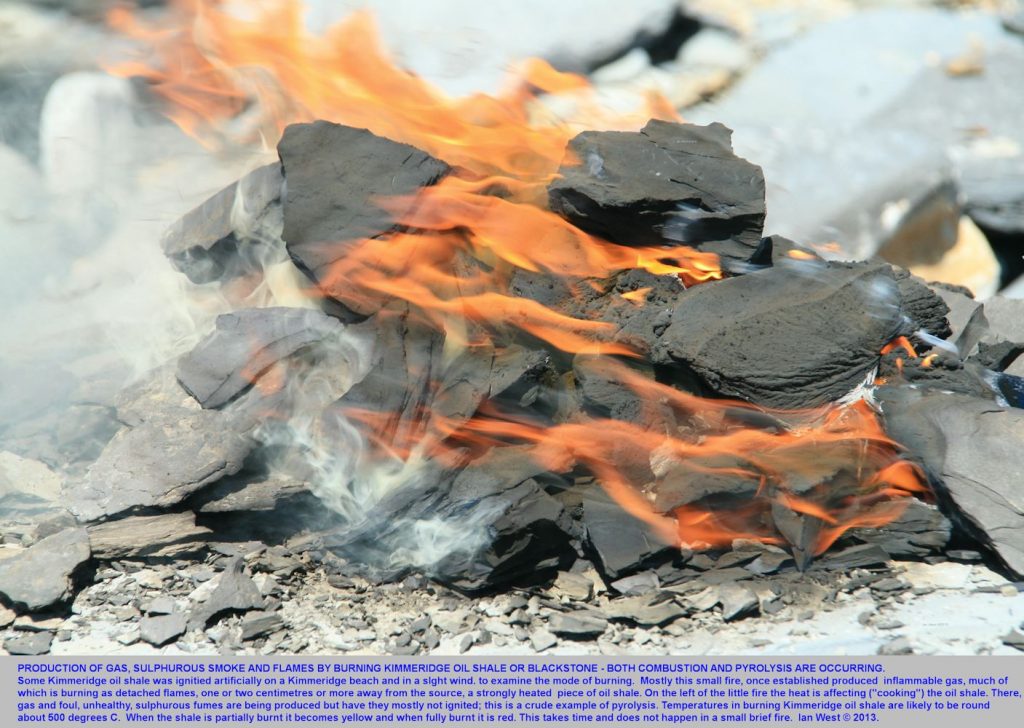
One notable example is the use of oil shale in Iron Age salt production at Kimmeridge in Dorset, England. Archaeological evidence has shown that the Kimmeridge Shale, an oil shale found in the area, was used as a fuel source to heat ceramic vessels known as briquetage pans. These pans were used to boil and evaporate brine to extract salt. The oil shale’s combustible properties allowed the salt-makers to achieve the high temperatures needed for the brine evaporation process.
While the use of oil shale in prehistoric times was limited compared to other energy sources, such as wood and animal dung, the evidence of its utilisation in specific contexts sheds light on the resourcefulness and adaptability of ancient societies in utilising the materials available to them for various technological purposes.
Roman Period
Some evidence suggests that the Romans were aware of oil shale and its properties. They might have used it for specific purposes other than fuel. For example, there have been findings of oil shale artefacts in archaeological sites from the Roman period, indicating its presence and potential use.
The exact extent of oil shale utilisation during the Roman period is not well-documented, and its applications were likely limited compared to other available energy sources and materials. The widespread use of oil shale as a fuel source came much later in history, with technological advancements enabling efficient extraction and processing techniques.
11. Peat
Peat is a type of organic material formed from the partial decomposition of plant matter in waterlogged conditions. It is typically found in wetlands or peatlands and consists of partially decayed mosses, grasses, and other vegetation remains. Peat is rich in carbon and retains a high water content, making it a vital carbon sink and a valuable fuel source.
In prehistoric times, peat was used by ancient societies as a readily available and easily accessible source of fuel for various purposes. Some of the common uses of peat in prehistoric times include:
Heating and Cooking: Prehistoric people would collect dried peat from the surface of peat bogs or wetlands and use it for heating and cooking. They would burn peat in open fires or simple hearths for warmth and cooking food.
Lighting: Peat was also utilised as a source of light. It would be dried and used as fuel for torches, providing illumination during the night.
Preservation: Peat bogs have unique properties that facilitate the preservation of organic materials. Archaeological finds such as ancient tools, weapons, and human bodies have been exceptionally well-preserved in peat bogs, giving us valuable insights into prehistoric cultures.
Construction: In some regions, peat was used as a construction material. It was dried and used as a form of insulation or as a component of building materials for simple structures.
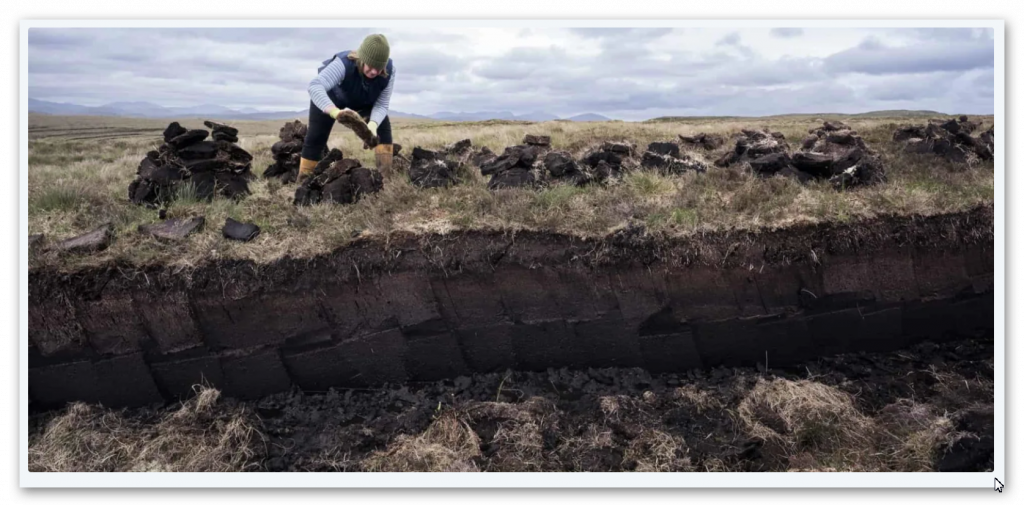
Prehistoric Times
Prehistoric Britain has several peat sites that have been of archaeological interest due to their preservation of organic materials and insights into prehistoric cultures. Some notable peat sites in prehistoric Britain include the Somerset Levels in southwest England have extensive peat bogs that have yielded significant archaeological finds. One of the most famous discoveries was the Sweet Track, a prehistoric wooden trackway dating back to around 3800 BC, which was found preserved in the peat.
Flag Fen, located near Peterborough in eastern England, Flag Fen is an archaeological site with well-preserved prehistoric wooden structures and artefacts preserved in the peat. Shapwick Heath, part of the Avalon Marshes in Somerset, is another critical peat site that has yielded evidence of prehistoric occupation and activity.
Fiskerton in Lincolnshire is known for its waterlogged deposits that have preserved wooden structures and artefacts dating back to the Bronze Age. Star Carr, located in North Yorkshire, is an important Mesolithic site with evidence of hunter-gatherer activity and well-preserved organic remains, including wooden artefacts and bone tools.
Mount Sandel in Northern Ireland is one of the earliest known settlements in Ireland, dating back to the Mesolithic period. The site’s waterlogged conditions have preserved critical archaeological remains.
These peat sites have provided valuable insights into prehistoric life in Britain, as the waterlogged conditions of peat bogs have preserved organic materials that would otherwise have decayed over time. Archaeological excavations at these sites have revealed ancient structures, artefacts, tools, and even well-preserved human remains, offering a glimpse into the region’s daily lives, practices, and technologies of prehistoric communities.
Roman Period
In Roman Britain, several peat sites have been discovered, although they might not be as well-known as the prehistoric peat sites. Peatlands and wetlands were widespread in Roman Britain, and some of the peat sites that have yielded archaeological evidence from the Roman period include:
Glastonbury Lake Village was a prehistoric settlement on a wooden platform in a lake. While the site primarily dates to the Iron Age, there is evidence of Roman influence and occupation, making it relevant to Roman Britain. The wetland conditions of the site have preserved organic remains, including wooden structures and artefacts.
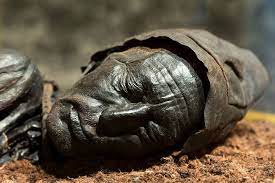
Though primarily a Bronze Age site, Must Farm in Cambridgeshire, England, also has evidence of Roman activity. The site is a well-preserved settlement built on stilts over a river channel and has yielded a wealth of artefacts, including Roman pottery and metal objects.
Located on the Isle of Wight, Brading Roman Villa is a well-preserved Roman villa complex with evidence of occupation from the 1st to the 4th centuries AD. The site includes a hypocaust (underfloor heating system) and Roman mosaics, which were preserved due to the waterlogged conditions of the area.
Although not a peat site, Vindolanda is an important Roman fort and settlement near Hadrian’s Wall in Northumberland, England. Excavations at Vindolanda have uncovered extensive organic materials, such as wooden writing tablets, shoes, and other artefacts, preserved in anaerobic soil conditions.
Richborough in Kent, England, was an important Roman port and fort during the Roman occupation. The site contains archaeological remains that provide insights into Roman military and trading activities.
It’s important to note that while some of these sites are situated in peatlands or areas with waterlogged conditions, not all of them are classified as peat sites in the strict sense. Nonetheless, wetlands and waterlogged environments have contributed to preserving organic materials from the Roman period in various locations across Britain.
Roman salterns (salt working sites) in Essex, Cambridgeshire, Norfolk, and Lincolnshire might have used peat to fuel boiling and evaporating brine in briquetage pans (Lane & Morris 2001).
12. Jet
Jet is a black, lustrous, and lightweight gemstone composed mainly of fossilised wood from ancient conifer trees, primarily of the species Araucariaceae. It is a form of lignite, a precursor to coal, and is formed from the remains of old trees that fell into stagnant, oxygen-deprived water and underwent a process of decomposition and fossilisation.
Jet has a long and intriguing history of use dating back to prehistoric times. During the prehistoric period, people discovered jet’s value and unique properties, leading to its utilisation for various purposes. Some ways in which jet was used during this era include:
Ornamental Use: Jet’s distinctive black colour and lustrous appearance made it a sought-after material for crafting ornaments and personal adornments. Prehistoric communities fashioned jet into beads, pendants, bracelets, and other jewellery items, which were likely worn for ceremonial, spiritual, and decorative purposes.
Symbolic and Ritual Objects: The prehistoric people recognised jet’s symbolic and spiritual significance. It is believed that jet had protective properties and was used to ward off evil spirits and negative energies. Amulets and talismans made from jet were possibly worn as protective charms.
Tools and Implements: Jet’s durability and relatively soft nature made it suitable for carving into tools and implements. Archaeological evidence suggests that prehistoric communities used jet to create cutting tools, such as knives, scrapers, and needles, which aided in various daily tasks like crafting, hunting, and preparing food.
Ritual and Burial Practices: Jet held special significance in prehistoric burial practices. It was often placed within burial sites, alongside the deceased, as a symbol of mourning and remembrance. Archaeologists have discovered jet artefacts buried with individuals in some ancient graves, suggesting its role in funerary rituals and practices related to the afterlife.
Trade and Exchange: Jet, a valuable and distinctive material, likely played a role in early trade networks. Prehistoric communities might have exchanged jet items with neighbouring groups or distant tribes, enhancing cultural interactions and economic ties.
The use of jet in the prehistoric period offers a fascinating glimpse into the ancient cultures’ artistic, spiritual, and practical sensibilities. Although our understanding of specific prehistoric societies and their usage of jet may remain limited, the archaeological evidence provides valuable insights into the significance of this unique gemstone in the daily lives and belief systems of our distant ancestors.
A significant portion of true jet used in Britain from the Bronze Age to the Roman Period originated from the Whitby coastline of North Yorkshire. This jet likely eroded from the Upper Lias (Lower Jurassic) shales, including the thin Upper and Lower Jet Beds, which constitute part of the cliff strata in the region. Jet beads production might have been facilitated by mining the most delicate laminae of fresh jet from these shales. However, specific extractive sites from this period have not been identified.
Prehistoric
The primary jet source during prehistoric times is believed to have come from natural deposits or surface collections rather than extensive mining operations. Some regions known for prehistoric jet use include the area around Whitby, in North Yorkshire, England, is renowned for its high-quality jet. Jet artifacts dating back to the Neolithic and Bronze Age have been found in this region, suggesting that the ancient inhabitants may have collected jet from the beach or small surface outcrops.
The Forest of Dean, located in Gloucestershire, England, is another region where jet artefacts have been found. As mentioned earlier, jet was associated with the Scowles, which are natural formations of fossilised wood that were later exploited by prehistoric communities for various purposes.
Jet was an important grave good accompanying inhumation burials in Early Bronze Age barrows. X-Ray Fluorescence analysis indicates that most of the jet beads found, such as those in the Kill y Kiaran necklace discovered in a Scottish barrow, were made of Whitby jet. Some beads might have been made from cannel coal, a similar but less lustrous form of mineral coal sourced from the Lias of the Dorset coast.
It is important to note that the evidence for prehistoric jet mines is scarce, and much of what we know about prehistoric jet usage comes from discovering jet artefacts in archaeological sites. If they existed, the exact locations of prehistoric jet mines might remain hidden due to the passage of time and the challenges of archaeological investigation. As research and archaeological techniques continue to evolve, there may be future discoveries that shed more light on the ancient sources and methods of jet acquisition during prehistoric times.
Roman
During the Roman period in Britain, there is evidence of jet mining and manufacturing in Whitby, North Yorkshire. The Romans were known to have been skilled artisans, and they recognised the value of jet for its ornamental and decorative qualities. The jet from Whitby was highly prized for its quality and became famous for making jewellery, amulets, and other personal adornments.
Whitby jet was already being used during the pre-Roman Iron Age, but it saw increased demand and popularity during the Roman occupation of Britain, which lasted from AD 43 to the early 5th century. Roman artisans and traders exported the Whitby jet to other parts of the Roman Empire, making it a sought-after commodity.
Archaeological evidence, such as jet artefacts found in Roman contexts and waste material from jet-working processes, suggests that the Romans actively mined and worked jet in the Whitby area. Roman jet workshops have been identified, where artisans would have shaped and polished the raw jet material into various items of adornment.
Jet continued to be used similarly in Roman burials, where female individuals were often buried with jet jewellery, particularly in inhumation and sometimes coffined burials of wealthy individuals. Some Roman finds they have been attributed to the Whitby area, with a possible specialist centre at South Shields (Allason Jones & Jones 1994; Allason Jones 2002). However, specific extractive sites from this period have yet to be identified.
13. Amber
Amber is a fossilised tree resin that has been hardened over millions of years. It often contains inclusions such as insects, plant matter, or other small organisms, making it a valuable and unique gemstone. The most common type of amber in Europe is from the Baltic region, but it can also be found in other parts of the world.
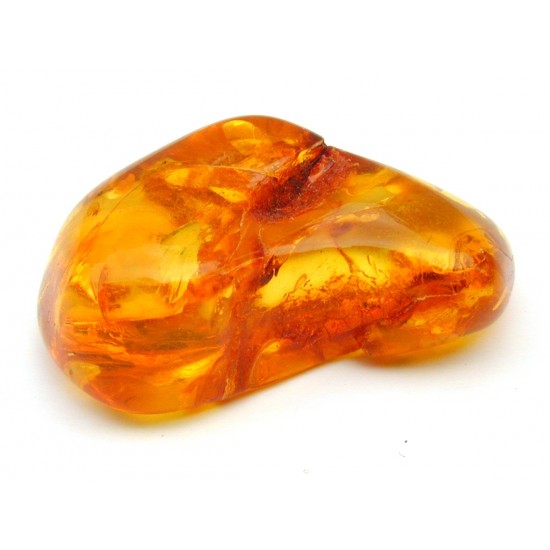
In prehistoric Britain, amber was significant and used for various purposes, as evidenced by archaeological discoveries and artefacts. Some of the ways amber was used in prehistoric Britain include:
Ornamental Use: Amber’s attractive colour and the fascinating inclusions it often contains make it a prized material for crafting ornaments and personal adornments. Prehistoric people used amber to create beads, pendants, necklaces, and other jewellery items worn as symbols of status, beauty, and possibly for ritual or spiritual purposes.
Symbolic and Ritual Objects: Amber was imbued with symbolic meaning and considered to have protective properties. It was believed to possess magical and healing qualities, and therefore, amber artefacts may have been used as talismans or amulets to ward off evil spirits and bring good luck.
Trade and Exchange: Amber was a valuable commodity in prehistoric times and likely played a role in trade networks. It could have been exchanged over long distances, making it significant in early trade routes and facilitating cultural interactions between regions.
Ritual and Burial Practices: Amber had spiritual connotations, and it is believed that prehistoric communities used it in burial practices and funerary rituals. Amber beads or ornaments may have been placed in graves alongside the deceased as grave goods or offerings for the afterlife.
Crafting and Artwork: Prehistoric artisans carved amber into intricate designs and figurines, showcasing their artistic skills. Amber objects may have served as votive offerings, religious artefacts, or simply as expressions of creativity.
The exact significance and usage of amber in prehistoric Britain can vary across different periods and regions. Archaeological finds and contextual evidence provide insights into its multifaceted role in the lives of our ancient ancestors. Amber’s allure and mystical qualities continue to captivate us to this day, as it did for the people of prehistoric Britain, leaving behind a legacy of creativity, spirituality, and cultural exchange.
Prehistory Times
In prehistoric times, the sources of amber used for jewellery, particularly within Early Bronze Age burials, are believed to have been obtained through beach collection along the east coast of Britain. The most common locations for the amber collection were East Anglia (Suffolk), and the source of this amber was likely the Baltic, and some boat trading must have been present.
Roman Period
During the Roman period in Britain, amber was primarily sourced from the Baltic Sea region’s shores, including present-day countries like Lithuania, Latvia, Estonia, Poland, Russia, and parts of Germany and Sweden. This region is known for its abundant amber deposits, and the Baltic Sea acted as a natural conveyor of amber to various parts of Europe, including Britain.
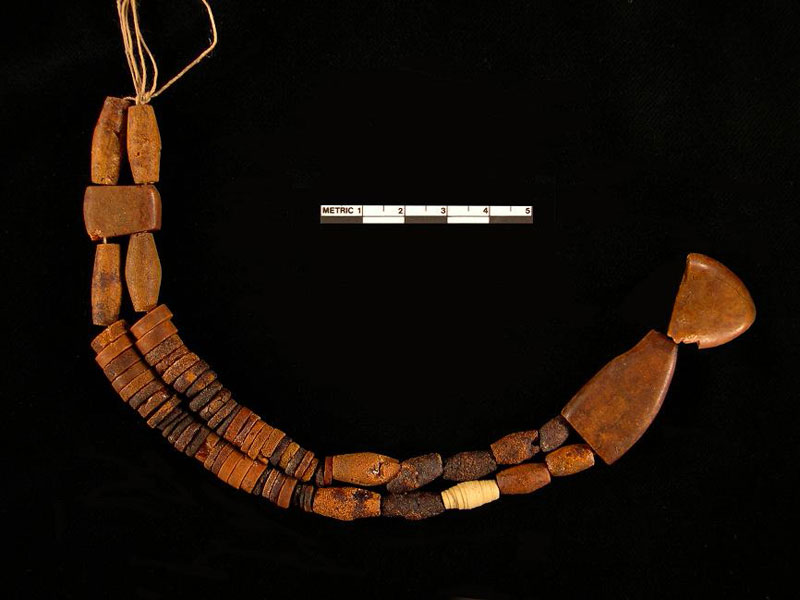
The Romans highly prized Amber from the Baltic Sea for its beauty and use in jewellery and other decorative objects. It was transported and traded along established maritime routes, reaching different parts of the Roman Empire, including Britain.
In Britain, amber from the Baltic would have been imported and traded through various ports, with southeastern regions like Kent and areas along the eastern coast likely having more access to such goods due to their proximity to the European mainland. Amber artefacts and beads have been discovered at Roman sites in Britain, providing evidence of the presence and use of Baltic amber during this period.
It’s important to note that while Baltic amber was the primary source during the Roman period, small amounts of other amber varieties might have also been found on British beaches, especially those washed up from the North Sea. However, Baltic amber remained the most sought-after and significant type during this time for its intrinsic beauty and connection to distant lands and cultures.
14. Flint
Flint is a hard, sedimentary rock composed mainly of microcrystalline quartz. It often has a conchoidal fracture, breaking into sharp-edged pieces. Due to its hardness and ability to produce a sharp edge when fractured, flint has been highly valued as a raw material for making tools and weapons since prehistoric times.
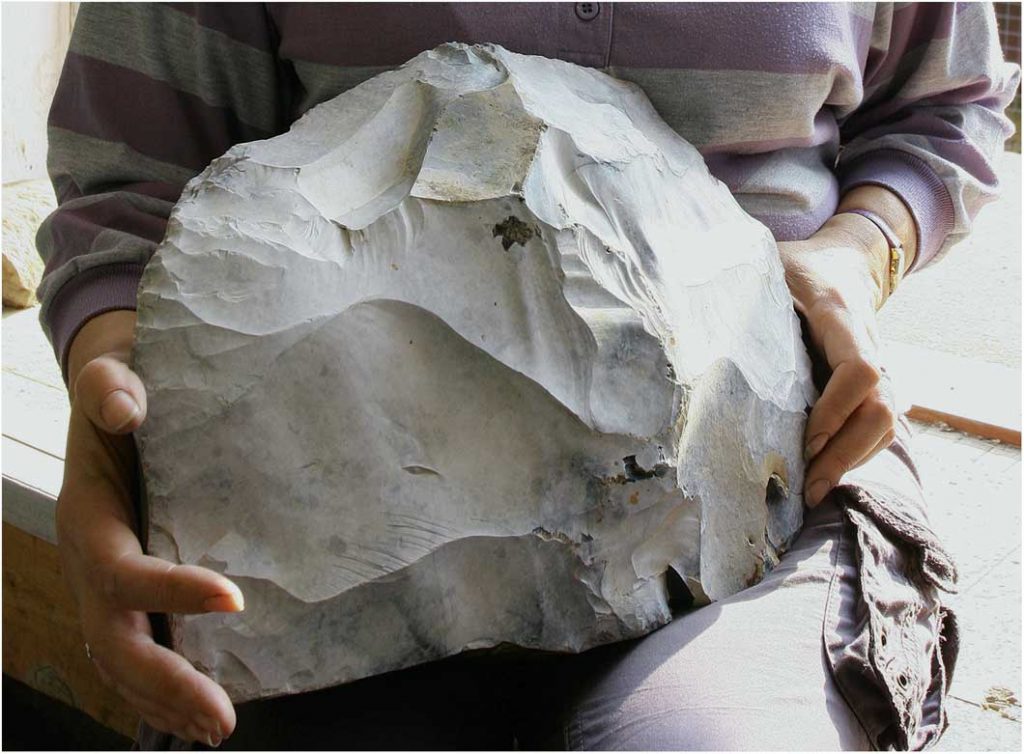
In prehistoric times, flint was one of the essential materials used by early human societies for a wide range of purposes. Some of the ways flint was used during this period include:
Stone Tools: Flint was extensively used to create various stone tools. Prehistoric humans would strike pieces of flint with another hard material (like another piece of flint or a bone) to produce sharp-edged flakes or blades. These flakes could then be retouched and shaped into tools such as knives, scrapers, arrowheads, spears, and cutting tools for butchering and preparing food.
Fire Starting: Flint’s ability to produce sparks when struck against a piece of iron pyrite or other metallic minerals made it a valuable material for starting fires. Sparks were generated by striking flint against suitable pyrite, which could ignite dry tinder and kindle a fire.
Weapons: Flint spearheads and arrowheads were crucial for hunting and defence. These sharp and lethal points were mounted on spears or arrows, allowing prehistoric humans to hunt for food and protect themselves from predators or other groups.
Carving and Artwork: Flint was used for artistic and decorative purposes besides functional tools. Prehistoric artists would carve intricate designs and engravings on flint pieces, creating artefacts with both practical and symbolic value.
Trade and Exchange: The availability of flint varied across regions, and its importance as a versatile material for tools and weapons made it an essential commodity for trade and exchange between different communities.
Ritual and Burial Practices: Flint artefacts were sometimes used in ritual and burial practices. Specific flint tools or arrowheads might have held symbolic significance and were sometimes included as grave goods or offerings in burial sites.
The use of flint in prehistoric times showcases the resourcefulness and ingenuity of early human populations. It played a central role in shaping their everyday lives, aiding in survival, tool-making, and cultural expression.
Today, the archaeological record of Flint artefacts provides valuable insights into our ancient ancestors’ lifestyles, technology, and cultural practices. The use of flint for tools and artefacts, excluding gunflint, is primarily associated with the prehistoric period. Burnt flint was used as a temper in pottery and was found in burnt flint mounds. The main flint application was worked flint tools, including flakes such as blades and scrapers and core tools like axes.
During the Neolithic, flint axes were traded as rough-outs or polished examples. It’s worth noting that some scholars believe that tools made from the best-mined flint might have had a ceremonial function beyond practical purposes (Barber et al. 1999).
Prehistoric Times
Flint mining during prehistoric times has been a subject of interest for researchers. A national survey by the RCHME (Royal Commission on the Historical Monuments of England) titled ‘Industry and Enclosure in the Neolithic‘ led to a monograph on flint mining sites in England (Barber et al. 1999).
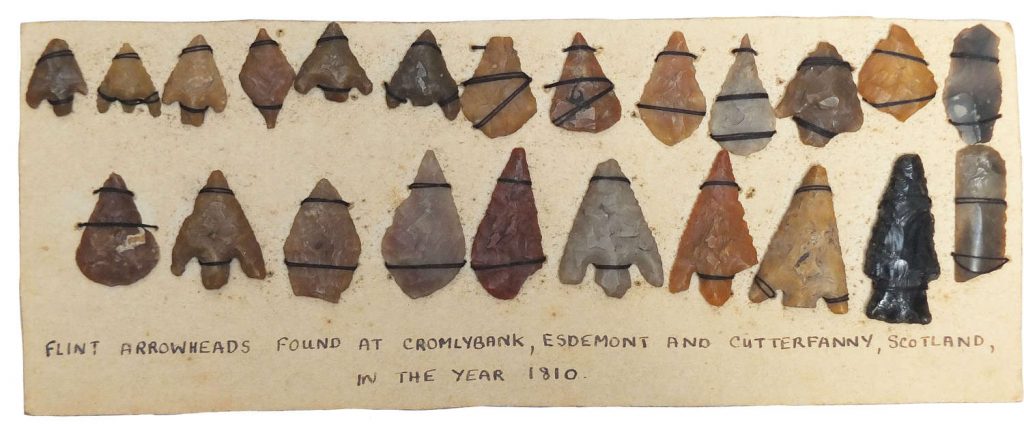
Salisbury Plain: In Wiltshire, Easton Down is a site with over 200 Neolithic shafts, possibly connected to Beaker settlements. Other sites near Easton Down include Durrington and Martin’s Clump. Martin’s Clump might have been an earlier site (4200 – 3700 BC), while Easton Down dates from around the end of this period to around 2700 BC.
South Downs: West Sussex contains the most prominent and possibly earliest group of Neolithic flint mines. The sites, such as Nore Down, Stoke Down, Long Down, Harrow Hill, Blackpatch, Church Hill/Tolmere Pond, and Cissbury, form a line along the downland ridge. Some of the earliest mines are Church Hill and Harrow Hill, dating from around 4500 to 3400 BC, contemporaneous with the construction causewayed enclosures. Cissbury, near Worthing, dates from about 4000 BC to about 2900 BC, overlapping with the beginnings of Stonehenge and the earliest Beakers.
Norfolk: The Buckenham Toft and Grime’s Graves sites in Norfolk form a small group within the Brandon area. Grime’s Graves, the largest group with over a hundred shafts, spanned from around 3000 BC to after 2000 BC, roughly coinciding with the period of Stonehenge.
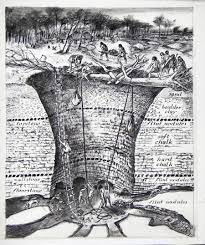
Hampshire: Over Wallop, a flint mine, was first reported by Stone in 1933. Ride later suggested that the excavation from a single shaft in Over Wallop parallels the Easton Down Mines in Surrey.
East Horsley: Two flint mine shafts, one dating to the Neolithic period and the other to the medieval period, were excavated in East Horsley in 1949. The Neolithic mine had two working floors and yielded various artefacts, including a Campigny-type axe, 80 implements, 715 wasters, potboilers, chalk balls, and Neolithic ‘A’ pottery. A Thames pick was also found at the site.
Essex: A flint mine near Grimsditch Wood was listed by Morris in the 1920s, but no further information is available on this site (Morris 1923, 63-4).
Surface extraction: Flint was widespread for artefact production in the Neolithic and Bronze Ages. Sites were common on the edges of the chalk outcrop on the North and South Downs, the Chilterns, and the chalk areas of Cambridgeshire, Suffolk, and Norfolk. Evidence of Lower Palaeolithic flint tools dating back to around 800,000 years BP has been found in interglacial deposits at Happisburgh on the North Norfolk coast, and at Boxgrove near Chichester, tools dating to approximately 500,000 years BP were discovered (Parfitt 2006).
Roman Period
Flint was used during the British Roman period, primarily for various functional purposes. The Roman period in Britain spanned from AD 43 to around AD 410 when the Romans occupied the territory. Some common uses of flint during the British Roman period included:
Tools and Weapons: Flint was used to make cutting tools such as knives, scrapers, and arrowheads. These tools were important for everyday tasks like hunting, butchering, and woodworking.
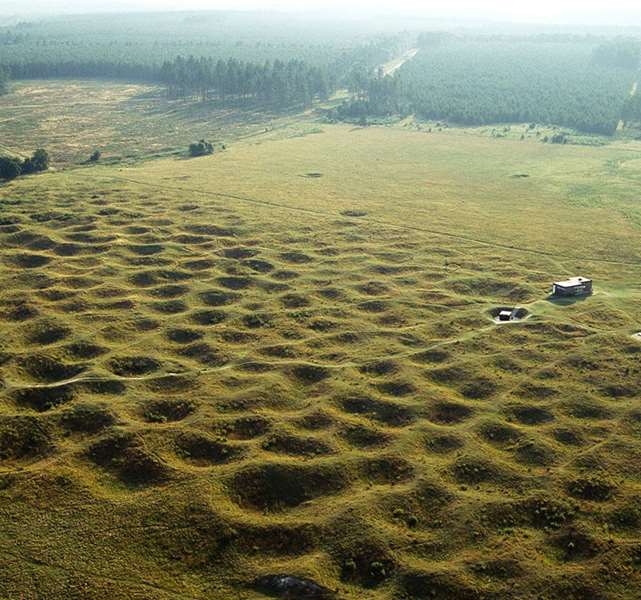
Construction: Flint was incorporated into various construction projects. Romans used it to build walls, pavements, and foundations, sometimes with other materials like mortar or clay.
Fire Starting: Flint and iron pyrite (fool’s gold) were often struck together to create sparks, which could then be used to start fires. This technique was employed for both practical purposes and in religious ceremonies.
Jewellery and Ornaments: Flint was used to create beads, pendants, and other decorative elements for personal adornment.
Flintlocks and Lighters: In later centuries, flintlocks became popular as ignition systems for firearms, but this development occurred after the Roman period.
Ritual and Ceremonial Objects: Flint had spiritual significance for prehistoric peoples, and some of these beliefs might have persisted into the Roman period. It’s possible that flint continued to be used in ritualistic contexts.
During the Roman period in Britain, several flint mines were in operation to extract this valuable material. The most well-known and significant Roman flint mines were located in southern England, particularly in the counties of Norfolk and Suffolk. These mines were vital sources of flint for the Roman settlements and construction projects in the region.
One of the most notable Roman flint mines is the Grimes Graves site near Thetford in Norfolk. Grimes Graves is an extensive complex of over 400 individual pits dug by Neolithic and early Bronze Age people as early as 5,000 years ago. These pits were later reworked and expanded by the Romans, who exploited the flint resources for various purposes.
At Grimes Graves and similar sites, the Romans used Flint for construction, tools, weapons, and other utilitarian items. They likely employed skilled workers to mine the flint using basic tools like antler picks and wooden shovels. The mines would have provided a steady flint supply, an essential resource during the Roman occupation of Britain.
It’s worth noting that besides Grimes Graves, other smaller flint mines were scattered across different regions of Britain during the Roman period. These mines were essential for supporting the local economy and the needs of Roman settlements in the area. However, detailed information about all these mines might be limited as archaeological research continues to uncover and reveal new insights into this aspect of Roman Britain’s history.
15. Polished Stone Axes
A polished stone axe is a prehistoric tool made from stone that has been carefully shaped, smoothed, and polished to create a cutting edge on one or both sides. These axes were an essential technological advancement in prehistoric times, representing an improvement over earlier unpolished stone tools.
The process of making a polished stone axe involves several stages:
Selection: A suitable stone is chosen for its hardness, durability, and workability. Common types of stone used for polished axes include flint, greenstone, and igneous rocks.
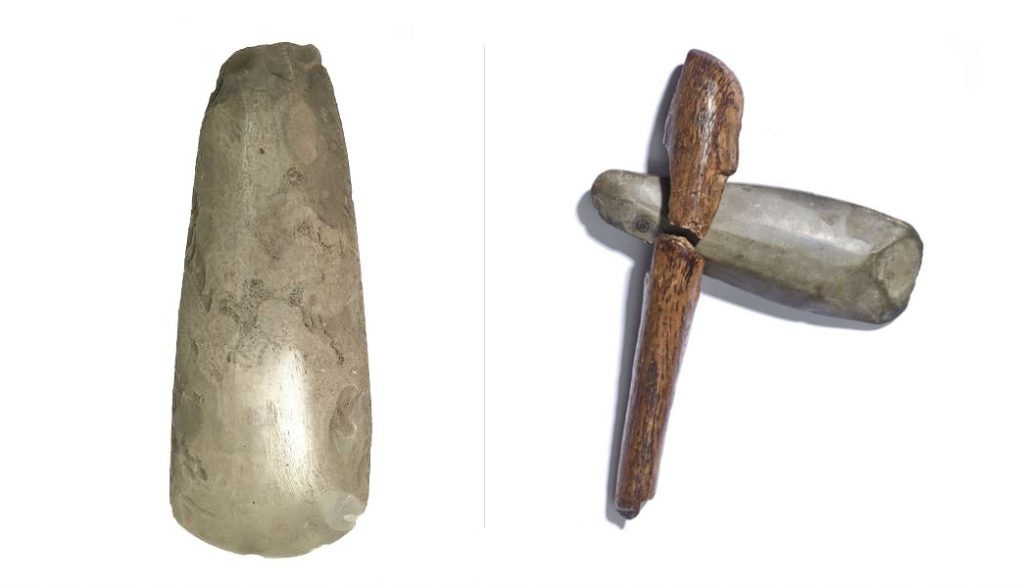
Rough shaping: The selected stone is roughly shaped into the desired axe form using harder stones such as hammers and chisels.
Grinding: The rough-shaped axe is then ground down to achieve a more defined shape and to remove any irregularities.
Polishing: The grinding process is followed by polishing, which involves rubbing the surface of the axe with abrasive materials like sand or other stones. This step creates a smooth and shiny surface, giving the axe its distinctive appearance.
Polished stone axes were incredibly versatile tools and served numerous functions in prehistoric British societies:
Woodworking: Axes were primarily used for cutting and shaping wood. They were essential for felling trees, cutting timber, and carving wooden objects for various purposes like constructing shelters, boats, and tools.
Agriculture: As agricultural practices developed, polished stone axes were used to clear land for farming, including the removal of trees and shrubs.
Hunting and Butchering: Axes were also used for processing game animals. They were employed to butcher and prepare meat for consumption.
Warfare and Defense: In times of conflict, polished stone axes could be used as weapons, either as handheld tools or hafted onto wooden shafts.
Symbolism and Rituals: Polished stone axes held significant symbolic value in prehistoric cultures. They were sometimes used in burial rituals or considered as status symbols among the elite.
The use of polished stone axes continued millennia until metalworking technology gradually replaced stone tools during the Bronze Age. Nevertheless, these axes played a crucial role in shaping the lives of prehistoric communities, helping them in various aspects of their daily lives and technological advancements.
Polished stone axes held significant cultural value during prehistoric times in different regions of Britain. Cornwall in the South West was an essential source of these axes in the early Neolithic period, with nine outcrops providing most of the polished axe assemblage from southern England. These axes were made from various rock types, including epidiorite, gabbro, picrite, and epidiorite.
The Great Langdale and Scafell areas were known for prolific polished stone axes production in the Lake District and Northern England. The sought-after rock used for these axes was an epitomised intermediate tuff of the Borrowdale Volcanic Series. The axes from these regions were widely distributed across Britain and even into Europe.
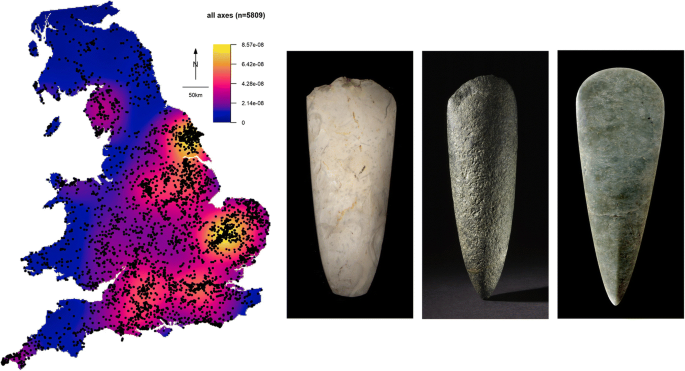
Other regions, such as Cumbria, also produced various polished stone implements, including axe hammers and perforated tools made of micaceous sub-greywackes and quartz dolerite. Locally distributed axes made of carbonate mudstone were linked to the Lias of North Yorkshire. The Midlands region had its sources of polished stone axes, such as an epitomised ashy grit from Charnwood Forest in Leicestershire and camptonite from near Nuneaton in Warwickshire.
These polished stone axes were essential tools and held cultural significance, reflecting the prehistoric communities’ technological advancements and social practices that created and used them.
Roman Period
During the Roman period in Britain, from AD 43 to around AD 410, polished stone axes were no longer used. By this time, metalworking had become widespread, and bronze and iron tools had largely replaced stone tools like polished stone axes.
The Romans were highly skilled metalworkers and brought advanced metalworking technologies to Britain. They used bronze and iron to create various tools, weapons, and everyday objects. Metal tools were more durable and efficient than stone tools, making them preferable for various tasks.
Despite the shift to metal tools, archaeological evidence shows that some prehistoric practices persisted in Roman Britain. For example, some communities continued to use older stone tools for specific tasks, and prehistoric artefacts, including polished stone axes, might have been passed down through generations and kept for their symbolic or ritualistic value.
16. Building Stone
Prehistoric building stone refers to stones used by ancient human societies before the advent of advanced construction materials and techniques. These stones were typically natural materials, often locally available, and were used to build various structures and monuments.
Types of Prehistoric Building Stones:
Megaliths: Large stones, such as standing stones and stone circles, were used to construct megalithic monuments. These massive stones were carefully positioned and arranged, often for religious or ceremonial purposes. Famous examples include Stonehenge in England and the Carnac stones in France.
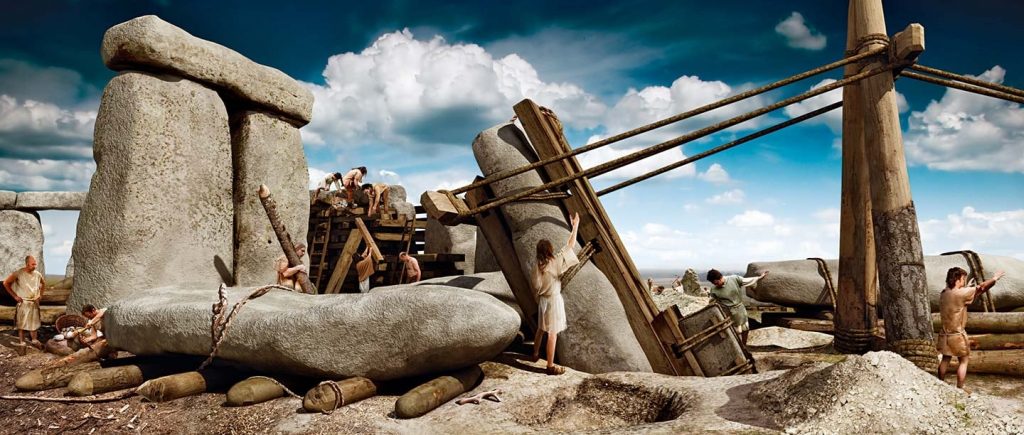
Dolmens and Burial Chambers: Prehistoric people used large stones to create structures like dolmens, which were megalithic tombs with a capstone supported by upright stones. Burial chambers, often found within burial mounds, were made using stone slabs.
Hillforts: Some prehistoric settlements were fortified with either dry stone walls (without mortar) or with stone and earth ramparts. These hillforts provided defensive positions and served as community centres.
Stone Tools and Weapons: Stone was used to craft various tools, including knives, scrapers, arrowheads, and spearheads. These tools were essential for hunting, food processing, and other day-to-day tasks.
Standing Stones: Independent standing stones, often associated with religious or spiritual significance, were raised by prehistoric cultures in various regions.
Building Foundations: Prehistoric people used stones to create the foundations of structures, such as circular huts or dwellings. The rocks provided stability and support for the walls.
Methods of Construction:
Dry Stone Construction: One of the most common methods of using prehistoric building stone was dry stone construction, where rocks were stacked without mortar. The stones were carefully selected and fitted together, relying on their shape and gravity to create stable structures.
Mortared Stone Construction: Prehistoric builders sometimes used a simple mortar made from mud or clay to hold stones together. This technique allowed for more precise construction, especially in structures like walls and foundations.
Post-and-Lintel: In megalithic monuments like dolmens and stone circles, massive stones were placed vertically (posts) and supported by horizontal stones (lintels).
Prehistoric building stone was an essential resource for ancient communities, providing the means to construct various structures, from simple dwellings to impressive monumental sites. These structures served practical, religious, and social purposes, and many of them still stand today as fascinating archaeological and historical landmarks.
Prehistoric Times
In Britain, archaeologists have identified and studied several prehistoric building stone quarries. These quarries were sources of the stones used to construct various prehistoric structures and monuments. The Preseli Hills in Pembrokeshire, Wales, are famous for providing the bluestones used in the construction of Stonehenge, one of the most iconic prehistoric monuments in the world. The exact transportation methods of these massive stones from Wales to Wiltshire, where Stonehenge is located, are still the subject of scholarly debate.
Craig Rhos-y-felin (Wales) – this quarry, also located in Pembrokeshire, Wales, has been identified as another potential source of the bluestones used at Stonehenge. It is believed that some of the smaller bluestones may have come from this quarry.
In the Lake District of England, Great Langdale was a significant source of the volcanic rock known as Group VI or Langdale Tuff. This stone was used to construct various stone axes during the Neolithic period. Cissbury Ring, an Iron Age hillfort in West Sussex, was the source of flint used to produce flint tools and weapons during prehistoric times.
Although primarily known for its Neolithic flint mines, Grimes Graves in Norfolk, England, also contains evidence of prehistoric quarrying for other types of stone used in construction and toolmaking. Trefignath on the island of Anglesey, Wales, was a prehistoric quarry that provided stone for constructing burial chambers and dolmens. Binstead Stone from quarries at Binstead on the Isle of Wight was used for construction in Iron Age sites in Southern England.
These are just a few examples of Britain’s prehistoric building stone quarries. Archaeological research continues to reveal more quarry sites and improve our understanding of how ancient communities sourced and used stone for construction during prehistoric times.
Roman Period
In the Roman period, various types of building stone were quarried and used across different regions of England. In the South-East, Barnack Limestone (oolite) was quarried for faced building stone at Barnack Holes and Hills in North Cambridgeshire. Ketton Stone and Collyweston Slate were used for Roman buildings in East Anglia, Lincolnshire, and the Midlands. Clunch (Totternhoe or Burwell Stone) from the Lower Chalk may also have been quarried during the Roman period at Reach or Burwell in Cambridgeshire.
In the Southwest of England, the use of stone for construction during the Roman period was predominantly associated with significant Roman cultural influence. Local stone was generally preferred due to the cost of transporting stone over long distances. However, some specific types of stone, such as Devonian sandstones and South Devon slates, were suitable for particular uses and were exploited for more extended periods. Beacon Hill near Shepton Mallet in Somerset was a source of Devonian sandstones, while the slates of South Devon were transported by sea to supply roofing material for Exeter.
In Avon, there are Roman stone quarries at Dundry Down, and evidence of Roman working is found near Beer on the South-East Devon coast. In Wiltshire, there is believed to be a Roman bell-pit quarry at Lady Down, Tisbury. Ham Hill Stone, an oolitic limestone, was quarried as a Roman building stone at Ham Hill near Stoke-sub-Hamdon in Somerset.
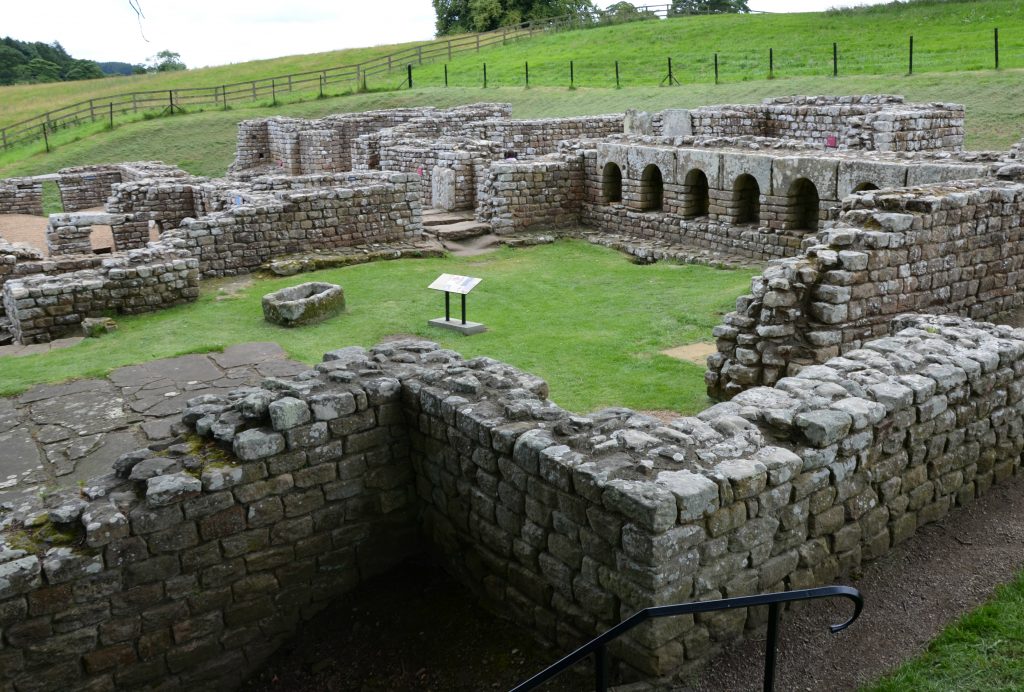
In the Midlands and Central England, the Precambrian Switherland Slate was quarried as roofing slate near Switherland, Leicestershire, and Stonesfield Slate was first quarried during the Roman period at Stonesfield in Oxfordshire for use as roofing slates in Cotswold villas.
In Northern England, Roman quarries are identified with inscriptions on quarry faces in Cumbria and Northumberland. These quarries included dolerite quarries on the Whin Sill, such as Crowdundle Roman Quarry, Gerrard House Roman Quarry, Wetherall Quarry, Coombcrag Roman Quarry, Pigeon Crag Roman Quarry, River Gelt Roman Quarry, Barcoomb Down Roman Quarry, and Queen’s Crag Roman Quarry. Traces of pick and wedge marks were found on the rock faces in some of these quarries, while others showed evidence of plug and feather working to split stone blocks.
17. Ornamental Stone
Ornamental stone refers to specific types of stones prized for their aesthetic qualities and used for decorative or artistic purposes during prehistoric times. These stones were considered valuable for their appearance, colour, texture, and other visually appealing characteristics. Prehistoric communities in Britain used ornamental stone to create various objects and artworks that served both practical and symbolic functions.
Examples of Ornamental Stones Used in Prehistoric Britain:
Serpentine: Serpentine is a greenish mineral used to create ornamental objects such as beads, pendants, and small figurines. Its attractive colour and relatively soft nature made it suitable for carving into intricate shapes.
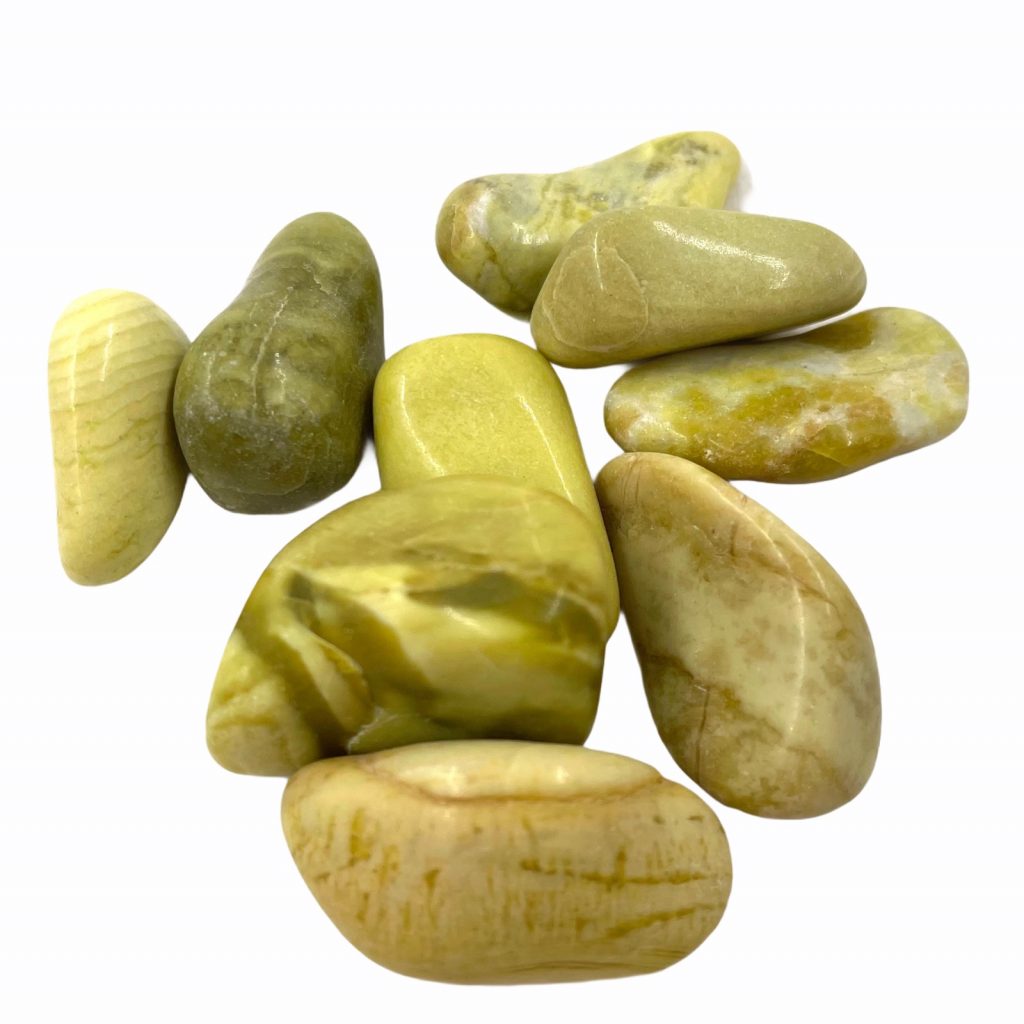
Haematite: Haematite is a reddish-brown mineral used to produce red and ochre pigments for painting and making beads and other small objects.
Uses of Ornamental Stone in Prehistoric Britain:
Personal Adornment: Prehistoric people used ornamental stones to create jewellery and decorative items for personal adornment. Beads, pendants, and bracelets made from these stones were worn as symbols of status or for religious and ritual purposes.
Ritual and Spiritual Practices: Ornamental stones held significant symbolic value in prehistoric cultures. They were often used in rituals, burials, and other religious practices as offerings or talismans.
Trade and Exchange: Some ornamental stones were rare and not locally available, leading to long-distance trade and exchange networks. These stones were highly valued commodities and played a role in interregional interactions.
Status and Identity: Wearing ornamental stone jewellery or carrying decorative items could signify individuals’ social status and identity within their communities.
Artistic Expression: Prehistoric artisans used ornamental stones to create intricate carvings and artworks, showcasing their skills and creativity.
The use of ornamental stone in prehistoric Britain reflects the importance of aesthetics and symbolism in the lives of ancient communities. These stones added beauty and meaning to their daily lives, contributing to a rich material culture that continues to be studied and admired by archaeologists and historians today.
Prehistoric Times
While specific ornamental stone sites from the prehistoric British period may not be as well-documented as other archaeological sites, there are several locations where decorative stones or artefacts made from them have been found. These discoveries offer insight into how prehistoric people used and valued ornamental stones. Here are some notable examples:
Stonehenge is one of Britain’s most famous prehistoric sites, known for its massive standing stones. Among the stones used in its construction are bluestones, some believed to have been brought from the Preseli Hills in Wales. These bluestones have ornamental value due to their unique appearance. Avebury is another significant Neolithic henge monument in Britain. Like Stonehenge, it contains standing stones with potential ornamental significance.
The Langdale area was a significant source of volcanic rock used for making stone axes. While primarily functional, some axes may have had ornamental or symbolic purposes. Grimes Graves is a well-known Neolithic flint mine site. While the site’s primary purpose was the extraction of flint for tools, it’s possible that some of the flint pieces were used for ornamental objects.
Folkton Drums are a set of three chalk cylinders decorated with ornate designs dating back to the Late Neolithic or Early Bronze Age. Their purpose is not fully understood, but they likely held ritual or symbolic significance.
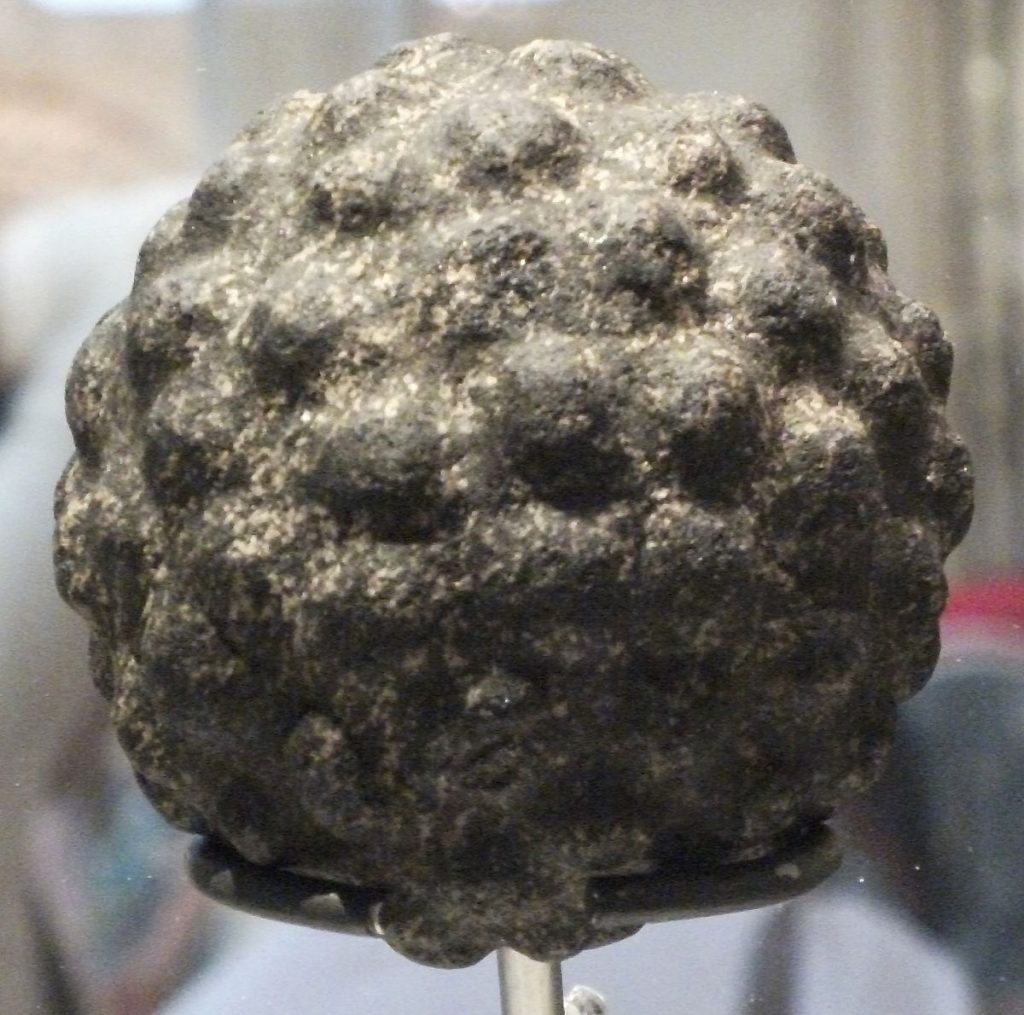
Flag Fen is an archaeological site containing a preserved prehistoric wooden causeway and ceremonial platform. Among the artefacts found at the site are a range of ornamental objects, including beads and pendants. Must Farm Bronze Age settlement is famous for its well-preserved artefacts, including jewellery made from jet and other decorative stones.
In Southwest England during the prehistoric period, Kimmeridge shale from Purbeck (Upper Jurassic) was extracted for the production of personal ornaments in the Iron Age. Shale cups made from this material have been found in Early Bronze Age barrows across Devon, Dorset, and Wiltshire, and the distribution of objects made from it extends far beyond the region due to its uniqueness as the only suitable source of shale for such purposes in Britain.
Roman Times
During the British Roman period, the use of ornamental stone continued, and some sites have revealed artefacts and objects made from various ornamental stones. However, it’s important to note that ornamental stones were just one component of the larger Roman material culture, which included a wide range of luxury items and decorative objects. Here are some notable examples of ornamental stone sites from the British Roman period:
Vindolanda was a Roman fort and settlement near Hadrian’s Wall. Archaeological excavations at this site have uncovered various ornamental objects, including jewellery and decorative items made from materials such as jet and shale. Corbridge was another Roman town situated along Hadrian’s Wall. Archaeological finds at this site included ornamental objects like jet, shale jewellery, and other decorative items.
Roman London, known as Londinium, was a significant trading and commercial centre during the Roman period. Excavations in London have revealed various ornamental objects, including jewellery made from precious and semi-precious stones like amethyst, agate, and garnet.
The Roman Baths in Bath were a famous site for relaxation and socialising. Archaeological discoveries at the site have included ornamental stones used in jewellery and small decorative objects. Fishbourne Roman Palace is one of the largest Roman villas discovered in Britain. It contained many ornamental items, including jewellery and other decorative objects made from various materials, including precious stones.
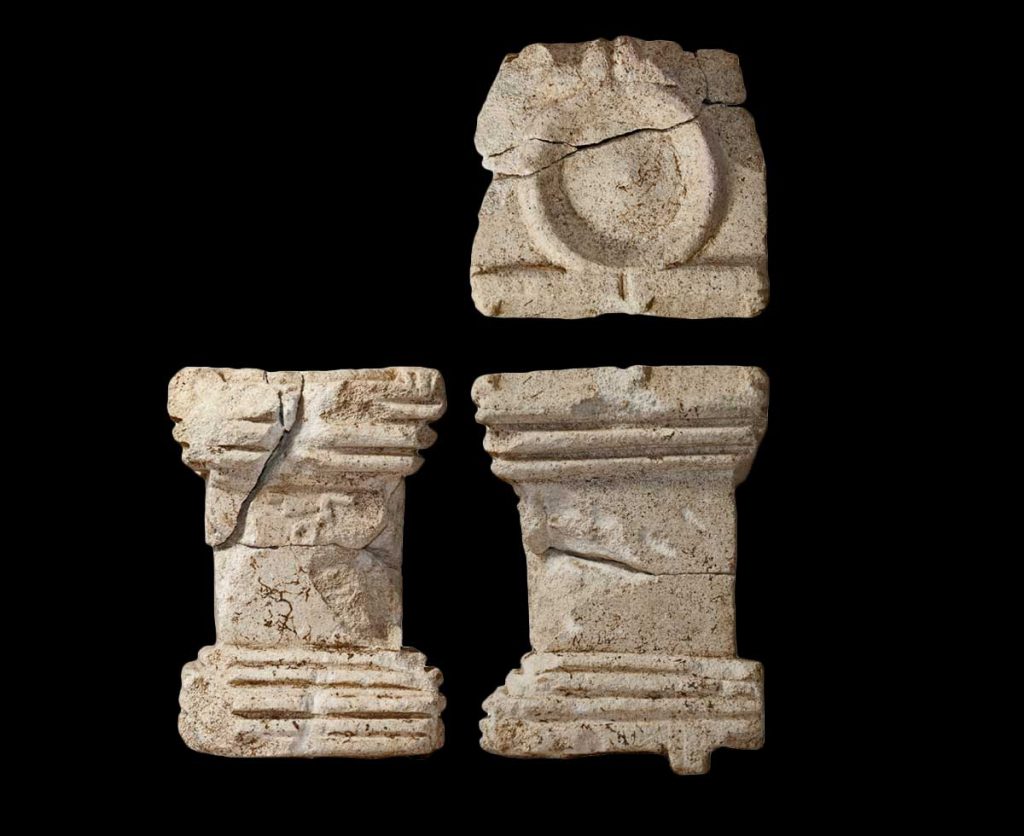
Caerleon, known as Isca Silurum in Roman times, was an important Roman fortress and settlement. Archaeological excavations have revealed ornamental stone artefacts such as jewellery and other decorative objects. Verulamium was a Roman town near present-day St Albans. Archaeological finds at the site have included ornamental stones used in jewellery and other luxury items.
Stone production from Purbeck expanded in volume and variety. Limestone from Purbeck was used not only for construction but also for creating tableware and furniture parts. In Cornwall, greisen and elvan (quartz porphyry) bowls developed as distinctive and possibly culturally significant artefacts among the Roman period inhabitants. However, the production of these items was on a very minor local scale, leaving little trace of extraction.
In South-East England, Purbeck Marble, an Upper Jurassic limestone with gastropod fossils, was extracted in the Sussex Weald as a decorative stone.
These are just a few examples of Roman sites in Britain where ornamental stone artefacts have been discovered. The Roman period in Britain was characterised by a diverse and interconnected culture, and the use of decorative stones added to the opulence and refinement of the Roman way of life. Many of these artefacts are now preserved in museums, providing valuable insights into the material culture of the time.
18. Limestone
Limestone is a sedimentary rock primarily composed of calcium carbonate, often in the form of the mineral calcite. It forms through the accumulation and compaction of marine organisms such as coral, shells, and algae over millions of years. Limestone comes in various colours, including white, grey, beige, and black, depending on the impurities present in the rock.
In prehistoric times, limestone was a valuable and versatile material that was extensively used for various purposes:
Building Construction: Limestone was a common building material in prehistoric times. It was used to construct walls, foundations, floors, and other structural elements in homes, settlements, and more significant monuments.
Sculpture: Limestone was carved into statues, reliefs, and other decorative elements for artistic and religious purposes. Many prehistoric cultures used limestone to create intricate and impressive sculptures.
Tools and Weapons: Limestone was sometimes used to create functional tools and weapons. While not as durable as harder stones like flint or obsidian, it could still be fashioned into knives, scrapers, and other implements.
Burial Monuments: Limestone was used to construct burial monuments, such as tombs, sarcophagi, and burial chambers. Its relative softness made it easier to carve and shape for funerary purposes.
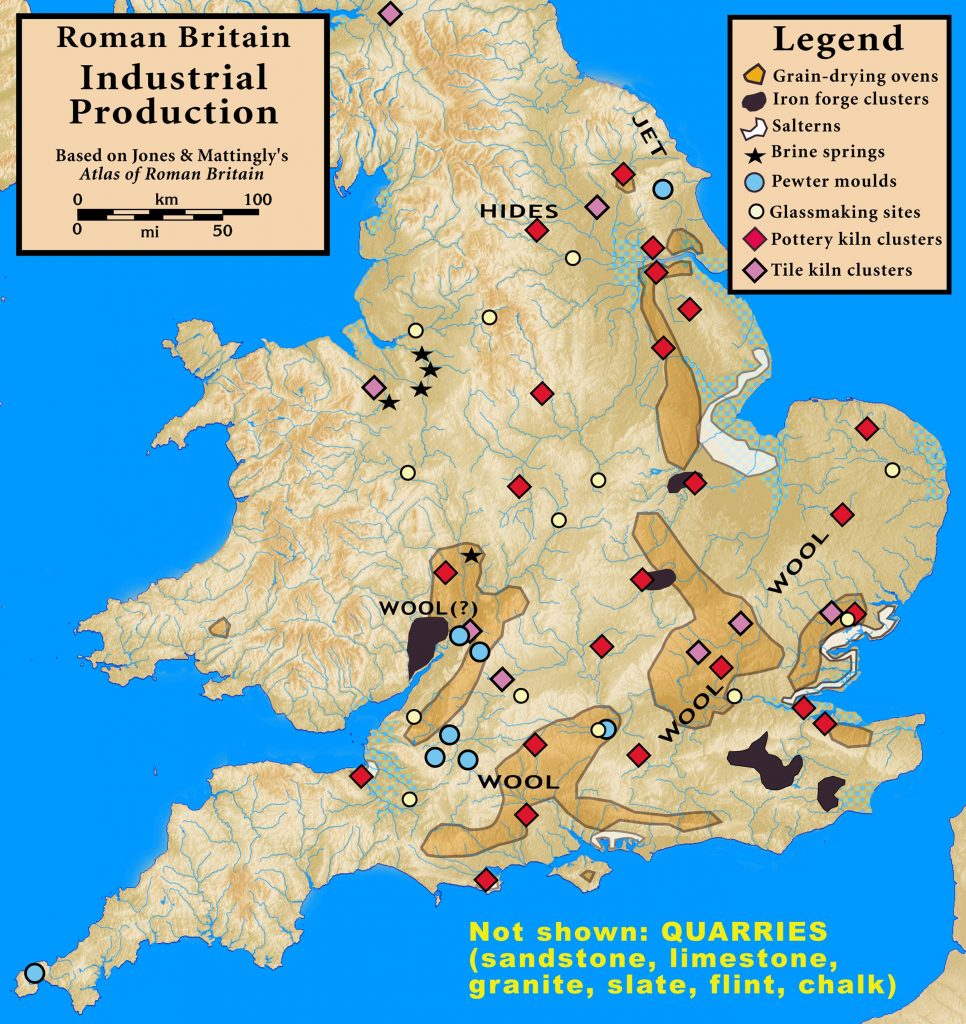
Ritual and Ceremonial Objects: Limestone was often used in religious and ritual contexts. It could be carved into altars, offering tables, or objects associated with spiritual practices.
Lime Production: Limestone was heated to produce quicklime, used in mortars and plasters for construction. This process, known as lime burning, played a vital role in early masonry and plasterwork.
Pigments: Some limestone varieties contain natural pigments, making them suitable for producing white or coloured paints and dyes.
Limestone’s widespread availability and ease of shaping made it a valuable resource for prehistoric societies. It was often sourced locally, but in some cases, it might have been traded over longer distances, contributing to cultural exchange and interactions between different communities.
Prehistoric Times
Specific lime production sites from prehistoric times in Britain are challenging to identify and document due to the absence of written records and the limited archaeological evidence. Lime production during prehistoric times was likely carried out on a small scale and on an as-needed basis. Prehistoric communities would have produced lime locally using simple methods, such as burning limestone in small kilns or hearths.
However, some archaeological evidence suggests that lime burning might have occurred at various settlements and campsites throughout prehistoric Britain. Here are a few factors that could indicate potential lime production sites:
Remains of Lime Kilns: Archaeologists occasionally discover remnants of ancient lime kilns or hearths used for lime burning. These structures are indicative of lime production activity.
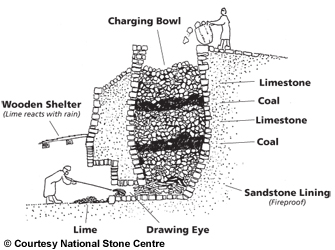
Lime-Related Artifacts: Artifacts associated with lime production, such as burnt limestone, quicklime, or lime plaster, might be found during excavations at prehistoric sites.
Proximity to Limestone Outcrops: Lime production requires a source of limestone, so prehistoric lime sites are likely to be located near natural limestone deposits.
Usage Patterns: Archaeological evidence of lime-based materials in constructing prehistoric structures, such as lime mortar or plaster, could suggest local lime production.
Ethnographic Comparisons: Ethnographic studies of traditional lime-burning practices in other regions can provide insights into the potential techniques used by prehistoric communities.
It’s important to note that the evidence for prehistoric lime production in Britain is relatively scarce compared to later historical periods. The study of prehistoric lime production often relies on limited archaeological remains and careful interpretation of the available evidence. The LiDAR evidence of pits in the environment not associated with later roads indicates this small-scale mining for lime.
Roman Period
Lime was extensively used in building work, and lime burning was documented. The Romans used lime as a significant building material in Britain, and their concrete mix was based on lime and crushed pot and tile. Flare kilns were used for lime burning; examples of such kilns and associated limestone extraction have been found in various locations.
Some reported flare kilns and limestone extraction locations include Helpston near Peterborough, Wellingborough, Weekly in Northants, Cardington in Beds, Piercebridge, and Housesteads on Hadrian’s Wall. The kiln at Weekly matches the description given by Cato in 150 BC.
Another type of kiln, known as the clamp kiln, was excavated at Richborough and Cranborne Chase. Additionally, a Roman-dated limekiln was discovered at Womersley in Yorkshire. These limekilns were essential in producing lime for construction and other purposes during the Roman period in Britain.
19. Quernstone
A quernstone is a prehistoric tool used for grinding grains, seeds, and other materials to produce flour or meal. It consists of two flat, circular stones stacked on each other. The bottom stone, known as the “quern,” is stationary, while the upper stone, called the “handstone” or “muller,” is rotated by hand.
The quernstones were typically made from durable rocks such as sandstone, granite, or basalt. These stones were selected for their hardness and ability to withstand repeated grinding without wearing down quickly.
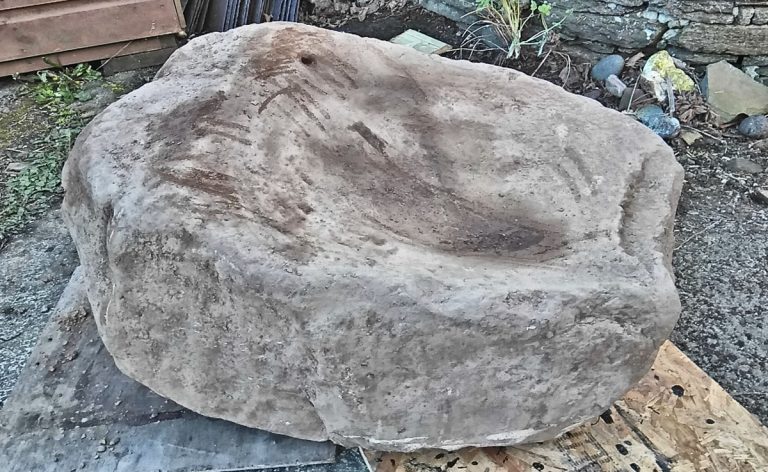
The process of using a quernstone involved the following steps:
Grain Preparation: The grains or seeds (such as barley, wheat, oats, or other cereals) were first prepared by winnowing and removing any chaff or debris.
Grinding: The grains were placed on the flat surface of the stationary quernstone. The person using the quernstone would then use the handstone to grind the grains in a circular motion. This action crushed the grains between the two stones, gradually breaking them into smaller particles and turning them into flour or meal.
Collecting the Flour: The resulting flour or meal would accumulate around the edge of the quern. It could be collected and used for baking or cooking.
Quernstones were an essential tool for prehistoric communities in Britain as they provided a means to process grains and produce food. Before the advent of more sophisticated milling technologies, quernstones were widely used for grinding grains into flour, making them a vital part of everyday life.
Prehistoric times
The Archaeological evidence of quernstones can be found at various prehistoric settlement sites in Britain, shedding light on ancient communities’ dietary habits and subsistence strategies. During the Neolithic to Early-Mid Iron Age, querns were used for grinding grain. Stationary saddle-quern blocks were used for milling on their upper faces with rubbing stones. Glacial erratic boulders and sarsen stones were commonly used in the South-East of England and East Anglia, while granite or hard crystalline rocks were sometimes preferred.
In the Late Iron Age, rotating hand mills or rotary querns appeared in Britain. Various rotary querns, such as the Hunsbury, Sussex, Wessex, and Yorkshire, were produced and distributed from quarry sources. Some Sussex beehive querns were linked to quarries within the Lower Greensand outcrop at Lodsworth in Sussex. Another quernstone production site was East Wear Bay, Folkestone in Kent, which thrived in the 1st century BC. By the Later Iron Age and Conquest Period, beehive rotary querns were made from rugged pebble conglomerate rock known as Hertfordshire Puddingstone, quarried at sites like Abbington Piggotts in Hertfordshire. However, their use declined with competition from imported lava querns from the Rhineland and gritstone handmill querns from Northern England.
Roman Period
In Central and Northern England, rotary querns made of Millstone Grit were produced at quarry sites such as Wharnecliffe and Rivelin by the end of the 1st century AD, and their use spread across Roman Britain.
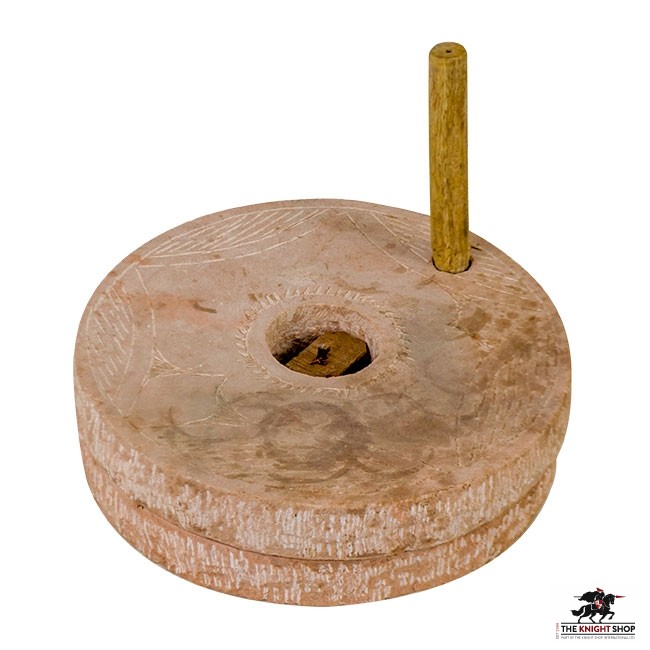
In the Roman period, the Devonian Old Red Sandstone (ORS) was used to manufacture rotary quern hand mills in Southwest England. Quarrying of ORS at Beacon Hill near Shepton Mallet may have begun in the prehistoric period to supply quernstone manufacture. Other local sources of suitable stone were likely used for querns as well.
20. Clay
Clay is a fine-grained, natural soil material rich in minerals like silica, alumina, and water. It forms from the decomposition of rocks and minerals over long periods. The properties of clay, including its plasticity when wet and its ability to harden when fired, make it an essential material for a wide range of applications.
In prehistoric Britain, clay was used for various purposes:
Pottery: Clay was one of the primary materials used for making pottery during prehistoric times. Prehistoric communities hand-built or wheel-thrown pottery vessels using local clay. These vessels were used for cooking, food storage, and other everyday purposes.
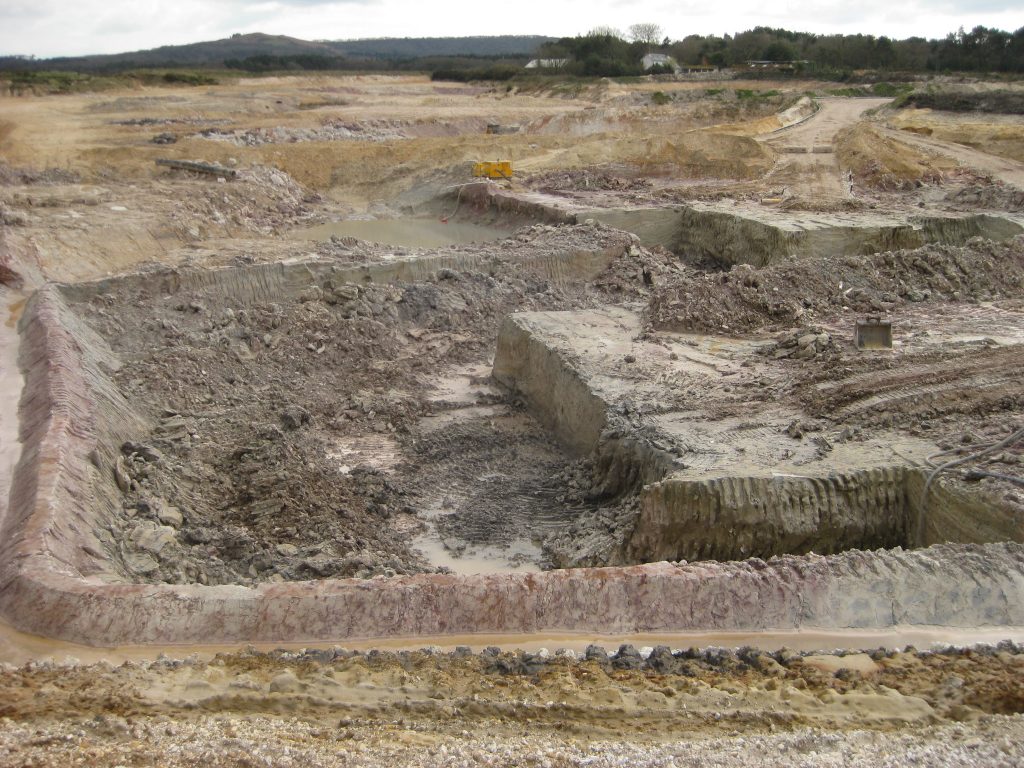
Bricks and Tiles: Clay-made bricks and tiles for construction. Bricks made from clay were sun-dried or fired to harden them and used for building walls and structures.
Figurines and Sculptures: Prehistoric artisans used clay to create figures and small sculptures for religious, ritual, and artistic purposes. These objects often had symbolic or spiritual significance.
Seals and Tokens: Clay seals and tokens were used in administrative and economic activities, particularly in recording transactions and identifying ownership.
Pipes and Ducts: In prehistoric plumbing systems, clay pipes were used to transport water or other fluids.
Pottery Kilns: Clay was used in constructing pottery kilns, where pottery was fired to harden it and create a durable finished product.
The use of clay in prehistoric Britain was not only practical but also played a significant role in the cultural and artistic expressions of the time. The archaeological record in Britain contains numerous examples of prehistoric pottery, clay figurines, and other clay objects that provide insights into the material culture and daily life of ancient communities.
Prehistoric Times
Specific clay mining sites from prehistoric times in Britain are challenging to identify and document due to the limited archaeological evidence and the lack of written records. Unlike other minerals like flint or metal ores, clay was likely extracted on a small scale and at various locations for local use.
However, archaeological studies and excavations have revealed evidence of prehistoric clay extraction and pottery production at several settlement sites and other locations across Britain. While these sites may not be solely dedicated clay mines, they provide insights into the prehistoric use of clay:
Hengistbury Head (Dorset, England) – this Iron Age settlement has revealed evidence of pottery production, suggesting that clay was likely sourced from the local area. Durrington Walls, a Neolithic site, contained evidence of large-scale pottery production, indicating clay was readily available in the vicinity. Mucking (Essex, England) – The Mucking excavation site has revealed pottery kilns dating back to the Iron Age and Roman period, indicating the region’s clay extraction and pottery production.
Grooved Ware pottery, a distinctive style from the Neolithic period, have also been found at various locations across Britain, suggesting local clay extraction for pottery production. Gabbroic clays of the Lizard in west Cornwall were identified as the source of an essential Neolithic ceramic fabric. This pottery distribution extended regionally, reaching sites like Windmill Hill and Maiden Castle.
It’s important to note that prehistoric clay extraction was likely carried out using simple tools and techniques, and the resulting pottery was often fired in open bonfires or small kilns. Unlike more significant mining operations for materials like metal or stone, clay extraction during prehistoric times would have been on a smaller, localised scale to meet the needs of local communities.
Roman Period
In the Roman period, numerous sources of clay were used in pottery and tile manufacture. Local kiln sites were established based on the availability of clay sources. For instance, in Cambridgeshire, pottery kilns were set up on the Gault Clay outcrop in Horningsea and Jurassic Ampthill Clay in Earith.
In Southwest England, around 95% of all pottery in Cornwall during the Roman period used gabbroic clays. The extensive exploitation of these clays over such a long period might have left significant evidence of their extraction, although no such evidence has been identified yet.
In South Devon, pottery using granitic clay was produced, with its distribution extending across Devon and beyond during the Late Roman period. Additionally, various grey wares were produced in western and southern Somerset and east Devon in the Roman period, suggesting some intensity of clay extraction in these regions.
21. Salt
Salt is a mineral composed primarily of sodium chloride (NaCl). It is essential for human and animal life and has been valued throughout history for preserving food and enhancing flavour. In prehistoric times, salt was a valuable and sought-after commodity.
Salt was used in various ways in prehistoric times:
Food Preservation: One of the most crucial uses of salt in prehistoric times was food preservation. By salting meat, fish, or other perishable foods, prehistoric people could extend their shelf life and store them for times of scarcity or during long journeys.
Flavouring: Salt enhances the taste of food, making it more palatable. Prehistoric people used salt to season their meals, making them more enjoyable and satisfying.
Trade and Commerce: Salt was essential for trade and exchange among prehistoric communities. Areas with natural salt deposits became important centres of commerce.
Rituals and Offerings: Salt had symbolic and ritualistic significance in some prehistoric cultures. It was used in religious ceremonies and offerings to deities.
Tanning and Leather Production: Salt played a role in tanning animal hides to produce leather.
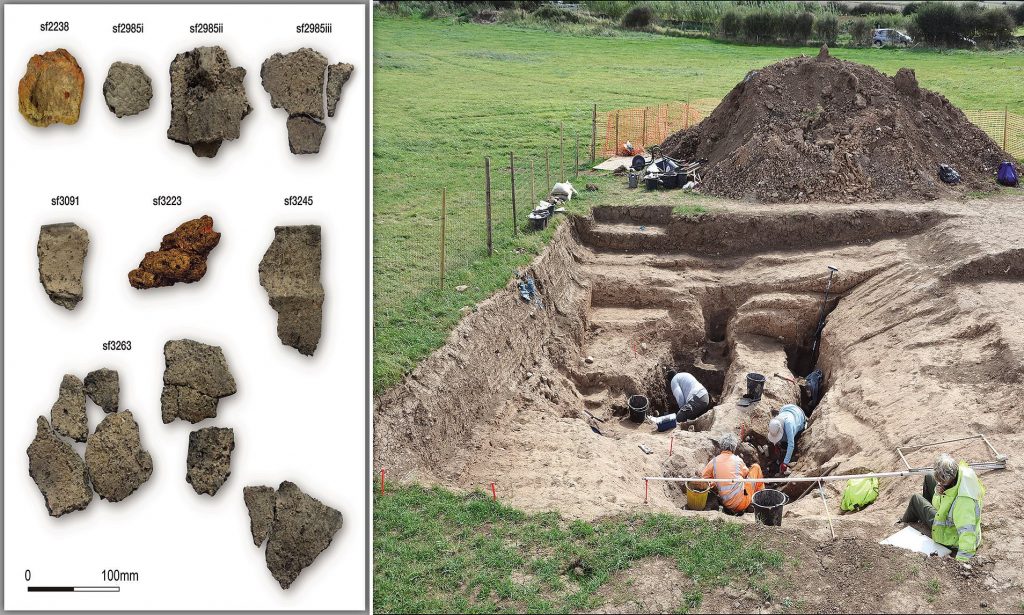
Prehistoric people obtained salt from different sources:
Sea Salt: Coastal communities could collect salt by evaporating seawater, leaving behind salt deposits. Seawater was poured into shallow pits or troughs, and as the water evaporated, salt crystals formed and were collected.
Salt Springs and Salt Lakes: Inland areas with salt springs or salt lakes could be sources of natural salt. Water from these sources would be evaporated to obtain salt.
Salt Mines: In some regions, prehistoric people might have mined salt deposits from the earth. These salt mines would provide a steady supply of salt.
The production and trade of salt were vital aspects of prehistoric economies, and the availability of salt resources often influenced settlement patterns and regional interactions. Salt was a valuable resource that significantly contributed to the well-being and development of prehistoric communities.
Prehistoric Times
Inland salt extraction during the Iron Age was limited to specific areas with natural brine springs. Notably, the salt towns of Cheshire, including Middlewich and Nantwich, and Droitwich and Upwich in Worcestershire, were significant centres for this activity. These natural brine springs provided a source of concentrated saltwater, which was collected and processed to produce salt.
However, most salt production during prehistoric and Roman times occurred along the coastal regions. Iron Age and Romano-British coastal salt extraction sites have been identified in various parts of Britain, such as the Lincolnshire fens, Norfolk, Dorset, Hampshire, Kent, Essex, and West Sussex, as well as other areas along the South Coast. Archaeological evidence of salt extraction in these regions includes the presence of fired-clay ‘briquetage,’ which consists of kiln furniture, boiling pans, and porous salt moulds or coarse pottery (VCP).
The salt extraction process involved various methods depending on the location and period. Direct boiling was one common technique, where seawater was boiled in pans to evaporate the water and obtain the salt residue. Coastal communities used specially designed briquetage pans for this purpose. Archaeological findings indicate the existence of kilns and pans that were used to boil seawater and produce salt in significant quantities.
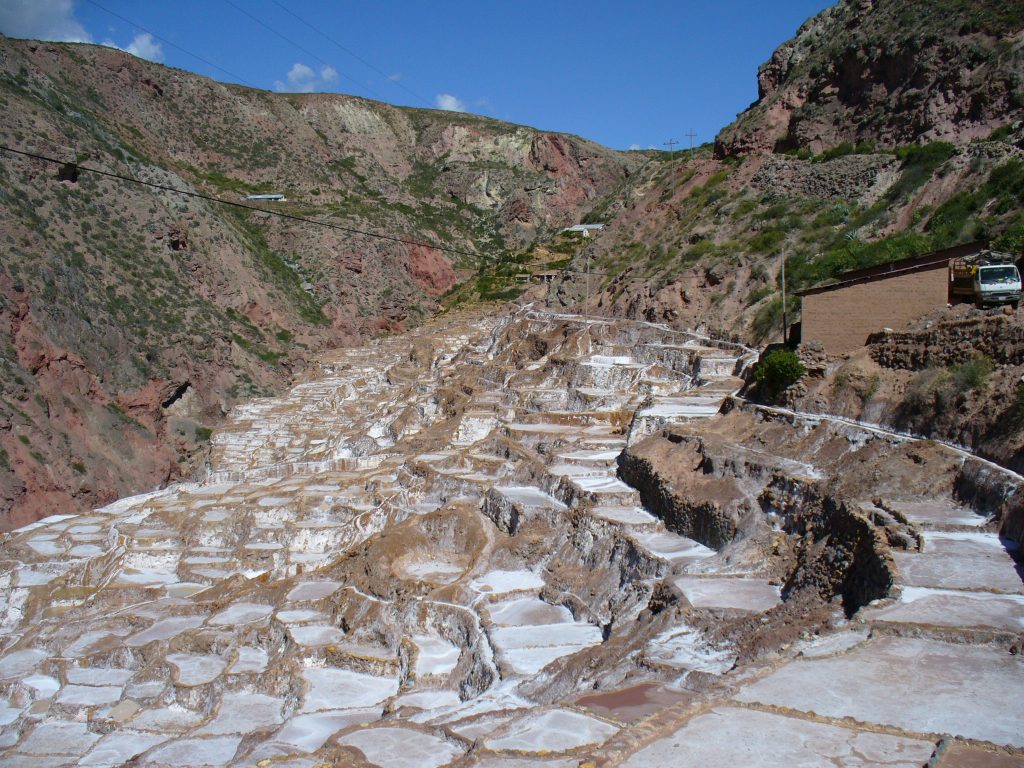
Another method employed by coastal saltmakers was pre-concentration. Before boiling, seawater was either pre-treated to remove some water or mixed with additional salt to create a concentrated brine. This step helped reduce fuel consumption during boiling, making salt production more efficient.
Some sites along the South Coast, such as in Norfolk, suggest using hemicylindrical boiling vessels on large rectangular ovens, which were efficient for direct boiling. However, most sites likely utilised pre-concentration techniques to optimise their fuel consumption.
Inland salt extraction was more limited and focused on natural brine springs in Cheshire and Worcestershire. Saltmakers tapped into brine springs and then boiled the brine to obtain salt at these locations.
Roman Period
During the Roman period in Britain, salt production was an essential industry, and several known salt production sites were scattered across different regions. These sites were strategically located near natural salt sources, and they played a crucial role in supplying salt for various purposes, such as food preservation, seasoning, and industrial processes. Some of the known salt production sites in Roman Britain include:
Droitwich (Worcestershire, England), known as “Salinae” during the Roman period, was one of the most significant salt production centres in Roman Britain. The town’s name itself is derived from “droit,” meaning “right” or “privilege,” referring to the ancient rights to extract salt from the local brine springs. Nantwich was another primary salt production site during Roman times. The area had natural brine springs that were exploited for salt extraction.
Wilderspool, located near modern-day Warrington, was another Roman site associated with salt production. Excavations have revealed evidence of Roman salt-making activities in the area. In addition to dedicated salt production centres, smaller salt pans or salterns were found along the coast and estuaries, where seawater evaporated to obtain salt. These salterns were widespread in Roman Britain, especially in coastal areas.
East Anglia was known for its brine springs, which were used to produce salt during the Roman period. Several sites in this region were involved in salt extraction.
The salt produced in these sites was not only used locally but was also traded and distributed throughout the Roman Empire. The salt industry was a significant source of revenue for the Roman government and contributed to the region’s economic prosperity during the Roman occupation.
Further Information
For more information about British Prehistory and other articles/books, go to our BLOG WEBSITE for daily updates or our VIDEO CHANNEL for interactive media and documentaries. The TRILOGY of books that ‘changed history’ can be found with chapter extracts at DAWN OF THE LOST CIVILISATION, THE STONEHENGE ENIGMA and THE POST-GLACIAL FLOODING HYPOTHESIS. Other associated books are also available such as 13 THINGS THAT DON’T MAKE SENSE IN HISTORY and other ‘short’ budget priced books can be found on our AUTHOR SITE. For active discussion on the findings of the TRILOGY and recent LiDAR investigations that is published on our WEBSITE you can join our FACEBOOK GROUP.
Other Blogs
1
a
- AI now Supports – Homo Superior
- AI now supports my Post-Glacial Flooding Hypothesis
- Alexander the Great sailed into India – where no rivers exist today
- Ancient Prehistoric Canals – The Vallum
- Ancient Secrets of Althorp – debunked
- Antler Picks built Ancient Monuments – yet there is no real evidence
- Antonine Wall – Prehistoric Canals (Dykes)
- Archaeological ‘pulp fiction’ – has archaeology turned from science?
- Archaeological Pseudoscience
- Archaeology in the Post-Truth Era
- Archaeology: A Bad Science?
- Archaeology: A Harbour for Fantasists?
- Archaeology: Fact or Fiction?
- Archaeology: The Flaws of Peer Review
- Archaeology’s Bayesian Mistake: Stop Averaging the Past
- Are Raised Beaches Archaeological Pseudoscience?
- Atlantis Found: The Mathematical Proof That Plato’s Lost City Was Doggerland
- ATLANTIS: Discovery with Dan Snow Debunked
- Avebury Ditch – Avebury Phase 2
- Avebury Post-Glacial Flooding
- Avebury through time
- Avebury’s great mystery revealed
- Avebury’s Lost Stone Avenue – Flipbook
b
- Battlesbury Hill – Wiltshire
- Beyond Stone and Bone: Rethinking the Megalithic Architects of Northern Europe
- BGS Prehistoric River Map
- Blackhenge: Debunking the Media misinterpretation of the Stonehenge Builders
- Brain capacity (Cro-Magnon Man)
- Brain capacity (Cro-Magnon Man)
- Britain’s First Road – Stonehenge Avenue
- Britain’s Giant Prehistoric Waterways
- British Roman Ports miles away from the coast
c
- Caerfai Promontory Fort – Archaeological Nonsense
- Car Dyke – ABC News PodCast
- Car Dyke – North Section
- CASE STUDY – An Inconvenient TRUTH (Craig Rhos Y Felin)
- Case Study – River Avon
- Case Study – Woodhenge Reconstruction
- Chapter 2 – Craig Rhos-Y-Felin Debunked
- Chapter 2 – Stonehenge Phase I
- Chapter 2 – Variation of the Species
- Chapter 3 – Post Glacial Sea Levels
- Chapter 3 – Stonehenge Phase II
- Chapter 7 – Britain’s Post-Glacial Flooding
- Cissbury Ring through time
- Cro-Magnon Megalithic Builders: Measurement, Biology, and the DNA
- Cro-Magnons – An Explainer
d
- Darwin’s Children – Flipbook
- Darwin’s Children – The Cro-Magnons
- Dawn of the Lost Civilisation – Flipbook
- Dawn of the Lost Civilisation – Introduction
- Digging for Britain – Cerne Abbas 1 of 2
- Digging for Britain Debunked – Cerne Abbas 2
- Digging Up Britain’s Past – Debunked
- DLC Chapter 1 – The Ascent of Man
- Durrington Walls – Woodhenge through time
- Durrington Walls Revisited: Platforms, Fish Traps, and a Managed Mesolithic Landscape
- Dyke Construction – Hydrology 101
- Dykes Ditches and Earthworks
- DYKES of Britain
e
f
g
h
- Hadrian’s Wall – Military Way Hoax
- Hadrian’s Wall – the Stanegate Hoax
- Hadrian’s Wall LiDAR investigation
- Hambledon Hill – NOT an ‘Iron Age Fort’
- Hayling Island Lidar Maps
- Hidden Sources of Ancient Dykes: Tracing Underground Groundwater Fractals
- Historic River Avon
- Hollingsbury Camp Brighton
- Hollows, Sunken Lanes and Palaeochannels
- Homo Superior – Flipbook
- Homo Superior – History’s Giants
- How Lidar will change Archaeology
i
l
m
- Maiden Castle through time
- Mathematics Meets Archaeology: Discovering the Mesolithic Origins of Car Dyke
- Mesolithic River Avon
- Mesolithic Stonehenge
- Minerals found in Prehistoric and Roman Quarries
- Mining in the Prehistoric to Roman Period
- Mount Caburn through time
- Mysteries of the Oldest Boatyard Uncovered
- Mythological Dragons – a non-existent animal that is shared by the World.
o
- Offa’s Dyke Flipbook
- Old Sarum Lidar Map
- Old Sarum Through Time…………….
- On Sunken Lands of the North Sea – Lived the World’s Greatest Civilisation.
- OSL Chronicles: Questioning Time in the Geological Tale of the Avon Valley
- Oswestry LiDAR Survey
- Oswestry through time
- Oysters in Archaeology: Nature’s Ancient Water Filters?
p
- Pillow Mounds: A Bronze Age Legacy of Cremation?
- Post Glacial Flooding – Flipbook
- Prehistoric Burial Practices of Britain
- Prehistoric Canals – Wansdyke
- Prehistoric Canals – Wansdyke
- Prehistoric Canals (Dykes) – Great Chesters Aqueduct (The Vallum Pt. 4)
- Prehistoric Canals (Dykes) – Hadrian’s Wall Vallum (pt 1)
- Prehistoric Canals (Dykes) – Offa’s Dyke (Chepstow)
- Prehistoric Canals (Dykes) – Offa’s Dyke (LiDAR Survey)
- Prehistoric Canals (Dykes) – Offa’s Dyke Survey (End of Section A)
- Prehistoric Canals (Dykes) – Wansdyke (4)
- Prehistoric Canals Wansdyke 2
- Professor Bonkers and the mad, mad World of Archaeology
r
- Rebirth in Stone: Decrypting the Winter Solstice Legacy of Stonehenge
- Rediscovering the Winter Solstice: The Original Winter Festival
- Rethinking Ancient Boundaries: The Vallum and Offa’s Dyke”
- Rethinking Ogham: Could Ireland’s Oldest Script Have Begun as a Tally System?
- Rethinking The Past: Mathematical Proof of Langdon’s Post-Glacial Flooding Hypothesis
- Revolutionising History: Car Dyke Unveiled as Prehistoric & the Launch of FusionBook 360
- Rising Evidence, Falling Rivers: The Real Story of Europe’s First Farmers
- Rivers of the Past Were Higher: A Fresh Perspective on Prehistoric Hydrology
s
- Sea Level Changes
- Section A – NY26SW
- Section B – NY25NE & NY26SE
- Section C – NY35NW
- Section D – NY35NE
- Section E – NY46SW & NY45NW
- Section F – NY46SE & NY45NE
- Section G – NY56SW
- Section H – NY56NE & NY56SE
- Section I – NY66NW
- Section J – NY66NE
- Section K – NY76NW
- Section L – NY76NE
- Section M – NY87SW & NY86NW
- Section N – NY87SE
- Section O – NY97SW & NY96NW
- Section P – NY96NE
- Section Q – NZ06NW
- Section R – NZ06NE
- Section S – NZ16NW
- Section T – NZ16NE
- Section U – NZ26NW & NZ26SW
- Section V – NZ26NE & NZ26SE
- Silbury Avenue – Avebury’s First Stone Avenue
- Silbury Hill
- Silbury Hill / Sanctuary – Avebury Phase 3
- Somerset Plain – Signs of Post-Glacial Flooding
- South Cadbury Castle – Camelot
- Statonbury Camp near Bath – an example of West Wansdyke
- Stone me – the druids are looking the wrong way on Solstice day
- Stone Money – Credit System
- Stone Transportation and Dumb Censorship
- Stonehenge – Monument to the Dead
- Stonehenge Hoax – Dating the Monument
- Stonehenge Hoax – Round Monument?
- Stonehenge Hoax – Summer Solstice
- Stonehenge LiDAR tour
- Stonehenge Phase 1 — Britain’s First Monument
- Stonehenge Phase I (The Stonehenge Landscape)
- Stonehenge Solved – Pythagorean maths put to use 4,000 years before he was born
- Stonehenge Stone Transportation
- Stonehenge Through Time
- Stonehenge, Doggerland and Atlantis connection
- Stonehenge: Discovery with Dan Snow Debunked
- Stonehenge: The Worlds First Computer
- Stonehenge’s The Lost Circle Revealed – DEBUNKED
t
- Ten Reasons Why Car Dyke Blows Britain’s Earthwork Myths Out of the Water
- Ten Things You Didn’t Know About Britain’s Prehistoric Flooded Past
- Ten thousand year old boats found on Northern Europe’s Hillsides
- Ten thousand-year-old boats found on Northern Europe’s Hillsides
- The “Hunter-Gatherer” Myth: Why It’s Time to Bury This Outdated Term
- The Ancient Mariners – Flipbook
- The Ancient Mariners – Prehistoric seafarers of the Mesolithic
- The Beringian Migration Myth: Why the Peopling of the Americas by Foot is Mathematically and Logistically Impossible
- The Bluestone Enigma
- The Cro-Magnon Cover-Up: How DNA and PR Labels Erased Our Real Ancestry
- The Dolmen and Long Barrow Connection
- The Durrington Walls Hoax – it’s not a henge?
- The Dyke Myth Collapses: Excavation and Dating Prove Britain’s Great Dykes Are Prehistoric Canals
- The First European Smelted Bronzes
- The Fury of the Past: Natural Disasters in Historical and Prehistoric Britain
- The Giant’s Graves of Cumbria
- The Giants of Prehistory: Cro-Magnon and the Ancient Monuments
- The Great Antler Pick Hoax
- The Great Chichester Hoax – A Bridge too far?
- The Great Dorchester Aqueduct Hoax
- The Great Farming Hoax – (Einkorn Wheat)
- The Great Farming Migration Hoax
- The Great Hadrian’s Wall Hoax
- The Great Iron Age Hill Fort Hoax
- The Great Offa’s Dyke Hoax
- The Great Prehistoric Migration Hoax
- The Great Stone Transportation Hoax
- The Great Stonehenge Hoax
- The Great Wansdyke Hoax
- The Henge and River Relationship
- The Logistical Impossibility of Defending Maiden Castle
- The Long Barrow Mystery
- The Long Barrow Mystery: Unraveling Ancient Connections
- The Lost Island of Avalon – revealed
- The Maiden Way Hoax – A Closer Look at an Ancient Road’s Hidden History
- The Maths – LGM total ice volume
- The Mystery of Pillow Mounds: Are They Really Medieval Rabbit Warrens?
- The Old Sarum Hoax
- The Oldest Boat Yard in the World found in Wales
- The Perils of Paradigm Shifts: Why Unconventional Hypotheses Get Branded as Pseudoscience
- The Post-Glacial Flooding Hypothesis – Flipbook
- The Post-Glacial Flooding Theory
- The Problem with Hadrian’s Vallum
- The Rise of the Cro-Magnon (Homo Superior)
- The Roman Military Way Hoax
- The Silbury Hill Lighthouse?
- The Stonehenge Avenue
- The Stonehenge Avenue
- The Stonehenge Code: Unveiling its 10,000-Year-Old Secret
- The Stonehenge Enigma – Flipbook
- The Stonehenge Enigma: What Lies Beneath? – Debunked
- The Stonehenge Hoax – Bluestone Quarry Site
- The Stonehenge Hoax – Flipbook
- The Stonehenge Hoax – Moving the Bluestones
- The Stonehenge Hoax – Periglacial Stripes
- The Stonehenge Hoax – Station Stones
- The Stonehenge Hoax – Stonehenge’s Location
- The Stonehenge Hoax – The Ditch
- The Stonehenge Hoax – The Slaughter Stone
- The Stonehenge Hoax – The Stonehenge Layer
- The Stonehenge Hoax – Totem Poles
- The Stonehenge Hoax – Woodhenge
- The Stonehenge Hospital
- The Subtropical Britain Hoax
- The Troy, Hyperborea and Atlantis Connection
- The Vallum @ Hadrian’s Wall – it’s Prehistoric!
- The Vallum at Hadrian’s Wall (Summary)
- The Woodhenge Hoax
- Three Dykes – Kidland Forest
- Top Ten misidentified Fire Beacons in British History
- Troy Debunked
- TSE – DVD Barrows
- TSE DVD – An Inconvenient Truth
- TSE DVD – Antler Picks
- TSE DVD – Avebury
- TSE DVD – Durrington Walls & Woodhenge
- TSE DVD – Dykes
- TSE DVD – Epilogue
- TSE DVD – Stonehenge Phase I
- TSE DVD – Stonehenge Phase II
- TSE DVD – The Post-Glacial Hypothesis
- TSE DVD Introduction
- TSE DVD Old Sarum
- Twigs, Charcoal, and the Death of the Saxon Dyke Myth
w
- Wansdyke – Short Film
- Wansdyke East – Prehistoric Canals
- Wansdyke Flipbook
- Wansdyke LiDAR Flyover
- Wansdyke: A British Frontier Wall – ‘Debunked’
- Was Columbus the first European to reach America?
- White Sheet Camp
- Why a Simple Fence Beats a Massive Dyke (and What That Means for History)
- Windmill Hill – Avebury Phase 1
- Winter Solstice – Science, Propaganda and Indoctrination
- Woodhenge – the World’s First Lighthouse?




